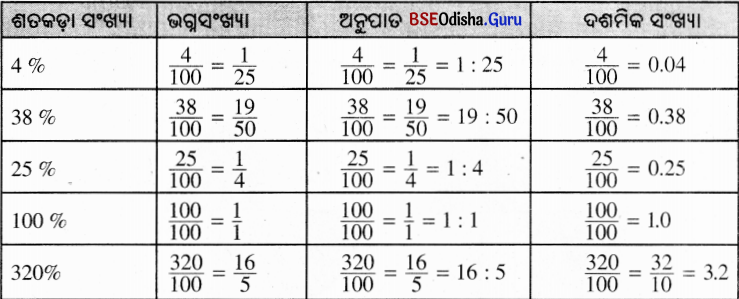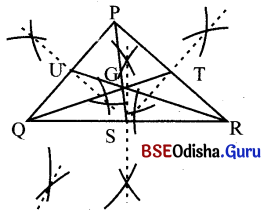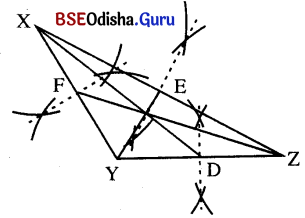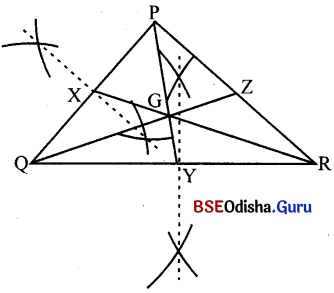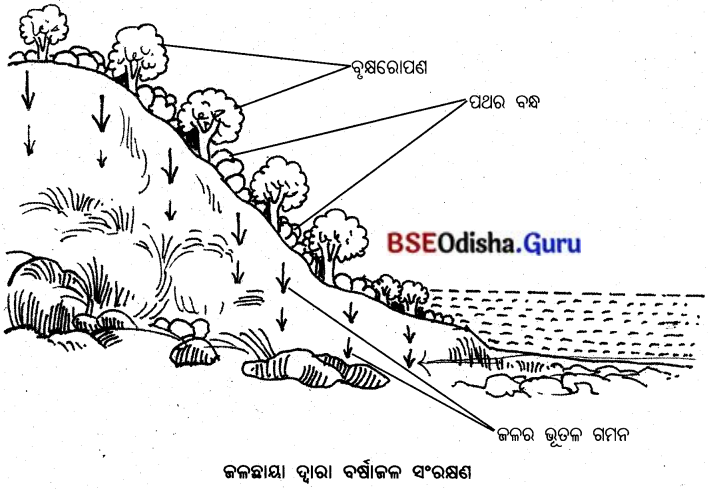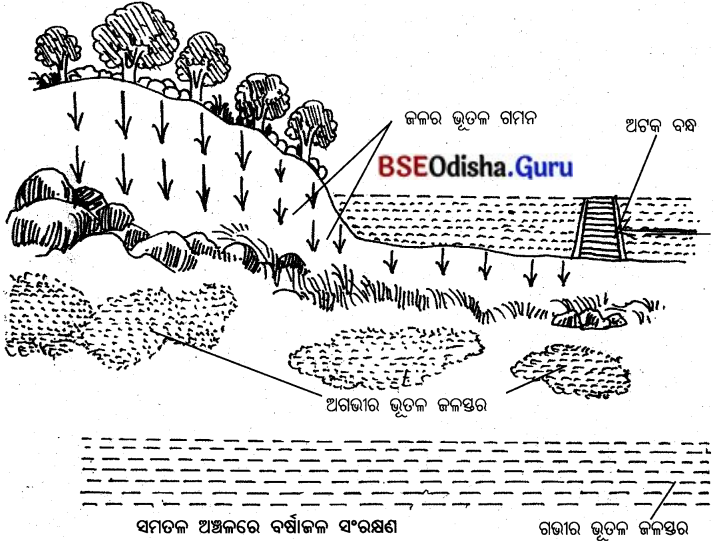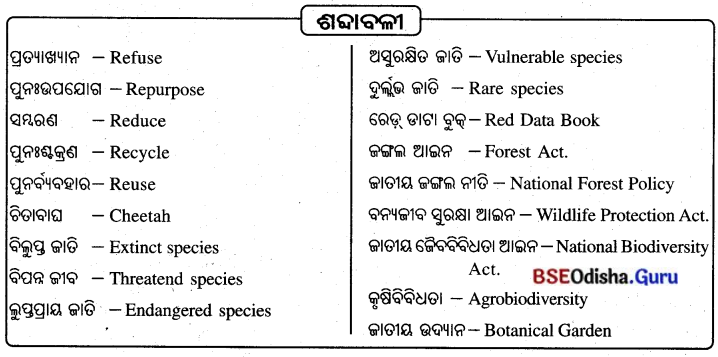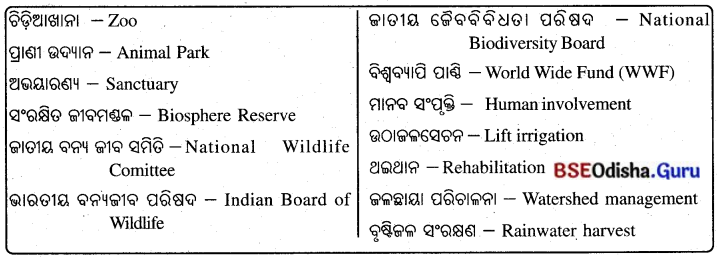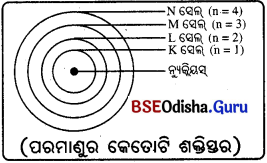Odisha State Board CHSE Odisha Class 12 History Solutions Chapter 15 ସ୍ଵତନ୍ତ୍ର ଓଡ଼ିଶା ପ୍ରଦେଶ ଗଠନ Short & Long Answer Questions.
CHSE Odisha 12th Class History Chapter 15 Short & Long Answer Questions in Odia Medium
ସଂକ୍ଷିପ୍ତ ଉତ୍ତରମୂଳକ ପ୍ରଶ୍ନୋତ୍ତର
A. ଦୁଇଟି | ତିନୋଟି ବାକ୍ୟରେ ଉତ୍ତର ଦିଅ ।
୧। ୧୮୮୫ରେ ଓଡ଼ିଶା ଗସ୍ତରେ ଆସିଥୁବା ଗଭର୍ଣ୍ଣର କିଏ ଥିଲେ ? ତାଙ୍କୁ କିଏ ସ୍ମାରକପତ୍ର ଦେଇ କ’ଣ ଦାବି?
Answer:
୧୮୮୫ରେ ଓଡ଼ିଶା ଗସ୍ତରେ ଆସିଥିବା ଗଭର୍ଣ୍ଣର ରିଚାର୍ଡ଼ ଥମ୍ପସନ୍ ଥିଲେ । ତାଙ୍କୁ ଉତ୍କଳସଭା ଏକ ସ୍ମାରକପତ୍ର ଦେଇ ଗଞ୍ଜାମ, ଜୟପୁର, ସମ୍ବଲପୁରକୁ ଓଡ଼ିଶା ସହିତ ଏକତ୍ର କରିବାପାଇଁ ଦାବି କରିଥିଲା ।
୨। ୧୮୮୮ରେ ବଙ୍ଗର କେଉଁ ଗଭଣ୍ଡିରଙ୍କୁ ସ୍ମାରକପତ୍ର ଦିଆଯାଇଥିଲା ଓ କ’ଣ ଆବେଦନ କରାଯାଇଥିଲା ?
Answer:
୧୮୮୮ରେ ବଙ୍ଗର ଲେପ୍ଟନାଣ୍ଟ ଗଭର୍ଣ୍ଣର ଏସ୍.ସି. ବେଲୀଙ୍କୁ ଉତ୍କଳସେଭା ପକ୍ଷରୁ ଏକ ସ୍ମାରକପତ୍ର ଦିଆଯାଇ ମଧ୍ୟପ୍ରଦେଶ, ମାନ୍ଦ୍ରାଜ ଓ ବଙ୍ଗରେ ମିଶିଥୁବା ଓଡ଼ିଆ ଭାଷାଭାଷୀ ଅଞ୍ଚଳକୁ ପୃଥକ୍ କରିବାକୁ ଆବେଦନ କରାଯାଇଥିଲା ।
୩ । କେଉଁମାନଙ୍କର ହସ୍ତକ୍ଷେପ ଫଳରେ ବଙ୍ଗାଳୀମାନଙ୍କର ଓଡ଼ିଆ ଭାଷା ଉଚ୍ଛେଦ କରିବାର ଉଦ୍ୟମ ବିଫଳ ହୋଇଥିଲା ?
Answer:
ଓଡ଼ିଶାର କମିଶନର ଟି.ଇ. ରେଭେନ୍ସା ଏବଂ ବାଲେଶ୍ଵର-କଟକର କଲେକ୍ଟର ଭାଷାବିଜ୍ଞାନୀ ଜନ୍ ବିମସ୍ଙ୍କ ହସ୍ତକ୍ଷେପ ଫଳରେ ବଙ୍ଗାଳୀମାନଙ୍କର ଓଡ଼ିଆ ଭାଷା ଉଚ୍ଛେଦ କରିବାର ଉଦ୍ୟମ ବିଫଳ ହୋଇଥିଲା ।
୪। ଓଡ଼ିଆ ଭାଷାରେ ବିଦ୍ୟାଳୟରେ ଶିକ୍ଷାଦାନର ବ୍ୟବସ୍ଥା କେବେ ଓ କିଏ କରିଥିଲେ ?
Answer:
୧୮୬୯ ଖ୍ରୀ.ଅ.ରେ ବଙ୍ଗର ଲେଫ୍ଟନାଣ୍ଟ ଗଭଣ୍ଡିର ସାର୍ ଏ.ସି. ବେଲୀ ଓଡ଼ିଶାର ସମସ୍ତ ପ୍ରାଥମିକ ବିଦ୍ୟାଳୟରେ ଓଡ଼ିଆ ଭାଷାରେ ଶିକ୍ଷାଦାନର ବ୍ୟବସ୍ଥା କରିଥିଲେ ।
୫ । ଗଞ୍ଜାମ ଓ ସମ୍ବଲପୁର ଯଥାକ୍ରମେ କେଉଁ ମସିହାରେ ଇଂରେଜମାନଙ୍କଦ୍ୱାରା ଅଧିକୃତ ହୋଇଥିଲା ?
Answer:
୧୭୫୯ ମସିହାରେ ଗଞ୍ଜାମ ଏବଂ ୧୮୪୯ ମସିହାରେ ସମ୍ବଲପୁର ଇଂରେଜମାନଙ୍କଦ୍ଵାରା ଅଧୂକୃତ ହୋଇଥିଲା ।

୬ । ନୀଳମଣି ବିଦ୍ୟାରନ କେଉଁ ପତ୍ରିକାରେ ଇଂରେଜ ସରକାରଙ୍କ ଭାଷାନୀତିର ସମାଲୋଚନା କରିଥିଲେ ଏବଂ ଏଥିପାଇଁ କିଏ ତାଙ୍କୁ ଅଭିନନ୍ଦନ ଜଣାଇଥିଲେ ?
Answer:
ନୀଳମଣି ବିଦ୍ୟାରମ୍ଭ ‘ସମ୍ବଲପୁର ହିତୈଷିଣୀ’ ପତ୍ରିକାରେ ଇଂରେଜ ସରକାରଙ୍କ ଭାଷାନୀତିର ସମାଲୋଚନା କରିଥିଲେ ଏବଂ ଏଥିପାଇଁ ତାଙ୍କୁ ସ୍ଵଭାବ କବି ଗଙ୍ଗାଧର ମେହେର ଅଭିନନ୍ଦନ ଜଣାଇଥିଲେ ।
୭ । ଲର୍ଡ କର୍ଜନ ଓଡ଼ିଶା ଗସ୍ତରେ ଆସିବାଦ୍ଵାରା କି ଲାଭ ହୋଇଥୁଲା ?
Answer:
ହୃଦ୍ବୋଧ କରିଥିଲେ । ଯାହା ଫଳରେ ୧୯୦୩ ଜାନୁୟାରୀ ୧ ତାରିଖରୁ ସମ୍ବଲପୁର କୋର୍ଟ କଚେରିରେ ଓଡ଼ିଆ ଭାଷା ପୁନଃ ପ୍ରଚଳିତ ହୋଇଥୁଲା ।
୮ | କେବେ ଓ କେଉଁ ପ୍ରଦେଶରୁ ପୃଥକ୍ କରି ସମ୍ବଲପୁରକୁ ଓଡ଼ିଶା ଡିଭିଜନରେ ମିଶାଇ ଦିଆଗଲା ।
Answer:
୧୯୦୫ ଜୁଲାଇ ୧୯ ତାରିଖରେ ସମ୍ବଲପୁରକୁ କେନ୍ଦ୍ରୀୟ ପ୍ରଦେଶରୁ ପୃଥକ୍ କରି ଓଡ଼ିଶା ଡିଭିଜନରେ ମିଶାଇ ଦିଆଗଲା ।
୯ । ସାଇମନ୍ କମିଶନଙ୍କ ଭାରତ ଗସ୍ତବେଳେ ଉତ୍କଳ ସମ୍ମିଳନୀର ସଭ୍ୟମାନେ କେଉଁଠାରେ ଓ କାହିଁକି ଭେଟିଥିଲେ ?
Answer:
ଏହି ସଭ୍ୟମାନେ କମିଶନଙ୍କ ନିକଟରେ ସ୍ଵତନ୍ତ୍ର ଓଡ଼ିଶା ପ୍ରଦେଶ ଗଠନ ପାଇଁ ଦାବି ଉପସ୍ଥାପନ କରିଥିଲେ ।
୧୦ । ଅଟ୍ ସବ୍କମିଟି କେଉଁ ଅଞ୍ଚଳକୁ ନେଇ ଓଡ଼ିଶା ପ୍ରଦେଶ ଗଠନ ପାଇଁ ସୁପାରିଶ କରିଥିଲା ?
Answer:
ଅଟ୍ ସବ୍କମିଟି ଓଡ଼ିଶା ଡିଭିଜନର ଅନୁଗୁଳ, ବଙ୍ଗର ମେଦିନିପୁର, ମାନ୍ଦ୍ରାଜ ପ୍ରେସିଡ଼େନ୍ସିର ଗଞ୍ଜାମ ଅଞ୍ଚଳ ଓ କେନ୍ଦ୍ରୀୟ ପ୍ରଦେଶର ଖଡ଼ିଆଳ ଅଞ୍ଚଳକୁ ଏକତ୍ରକରି ଏକ ସ୍ୱତନ୍ତ୍ର ଓଡ଼ିଶା ପ୍ରଦେଶ ଗଠନପାଇଁ ସୁପାରିସ କରିଥିଲା ।
୧୧ । କେବେ ଓ କେଉଁଠାରେ ସ୍ଵତନ୍ତ୍ର ଓଡ଼ିଶା ପ୍ରଦେଶ ଗଠନ ସମ୍ପର୍କରେ ମହାତ୍ମା ଗାନ୍ଧିଙ୍କୁ ଅବଗତ କରାଯାଇଥିଲା ?
Answer:
୧୯୩୧ ମାର୍ଚ୍ଚ ୨୯ରେ କରାଚୀଠାରେ ଅନୁଷ୍ଠିତ ଜାତୀୟ କଂଗ୍ରେସ ଅଧୂବେଶନରେ ଓଡ଼ିଶାର ପ୍ରତିନିଧୁମାନେ ସ୍ଵତନ୍ତ୍ର ଓଡ଼ିଶା ଗଠନ ଦାବି ସମ୍ପର୍କରେ ମହାତ୍ମା ଗାନ୍ଧିଙ୍କୁ ଅବଗତ କରିଥିଲେ ।
୧୨ । ଓ’ଡ଼ୋନେଲ କମିଟି ପ୍ରସ୍ତାବର ପ୍ରତିବାଦ କରିବାପାଇଁ କେବେ ଏବଂ କେଉଁଠାରେ ଉତ୍କଳ ସମ୍ମିଳନୀର ଜରୁରୀ ଅଧୁବେଶନ ବସିଥିଲା ?
Answer:
ଓ’ଡ଼ୋନେଲ କମିଟି ପ୍ରସ୍ତାବର ପ୍ରତିବାଦ କରିବାପାଇଁ ୧୯୩୨ ଖ୍ରୀ.ଅ. ଅଗଷ୍ଟ ୨୧ ତାରିଖରେ ବ୍ରହ୍ମପୁରଠାରେ ଲକ୍ଷ୍ମୀଧର ମହାନ୍ତିଙ୍କ ଅଧ୍ୟକ୍ଷତାରେ ଉତ୍କଳ ସମ୍ମିଳନୀର ଜରୁରୀ ଅଧୂବେଶନ ବସିଥିଲା ।
୧୩ । ସ୍ଵତନ୍ତ୍ର ଓଡ଼ିଶା ପ୍ରଦେଶ ଗଠନ ସମ୍ପର୍କରେ ଶ୍ଵେତପତ୍ର କେବେ ପ୍ରକାଶ ପାଇଥିଲା ଏବଂ ଏଥିରେ ପ୍ରସ୍ତାବିତ ଓଡ଼ିଶାର କ୍ଷେତ୍ରଫଳ କେତେ ଥିଲା ?
Answer:
ସ୍ୱତନ୍ତ୍ର ଓଡ଼ିଶା ପ୍ରଦେଶ ଗଠନ ସମ୍ପର୍କରେ ଶ୍ଵେତପତ୍ର ୧୯୩୩ ଖ୍ରୀ.ଅ. ମାର୍ଚ୍ଚ ୧୭ ତାରିଖରେ ପ୍ରକାଶ ପାଇଥିଲା ଏବଂ ଏଥିରେ ପ୍ରସ୍ତାବିତ ଓଡ଼ିଶାର କ୍ଷେତ୍ରଫଳ ୨୧,୫୪୫ ବର୍ଗ ମାଇଲ୍ ରଖାଯାଇଥିଲା ।
୧୪ । ମିଳିତ ସଂସଦୀୟ କମିଟି ଶ୍ଵେତପତ୍ର ପ୍ରସ୍ତାବିତ ଓଡ଼ିଶା ସହିତ କେଉଁ କେଉଁ ଅଞ୍ଚଳ ଯୋଗ କଲା ?
Answer:
ମିଳିତ ସଂସଦୀୟ କମିଟି ଶ୍ଵେତପତ୍ର ପ୍ରସ୍ତାବିତ ଓଡ଼ିଶା ସହିତ ଜୟପୁର ଜମିଦାରୀର ଅଂଶ, ଜଳନ୍ତର, ସାଲିହା ଏବଂ ପାରଳାଖେମୁଣ୍ଡି ସହର ସମେତ ପାରଳାଖେମୁଣ୍ଡି ଜମିଦାରୀର ଏକ ଅଂଶକୁ ଯୋଗ କଲା ।
୧୫ । ଭାରତ ଶାସନ ଆଇନ ୧୯୩୫ର କେଉଁ ଧାରାରେ ଓଡ଼ିଶାକୁ ଏକ ପୃଥକ୍ ପ୍ରଦେଶ ଭାବେ ସ୍ୱୀକୃତି ଦିଆଗଲା ଏବଂ କେବେ ଭାରତ ଶାସନ (ଓଡ଼ିଶା ଗଠନ) ନିର୍ଦେଶ ଘୋଷିତ ହେଲା ?
Answer:
ଭାରତ ଶାସନ ଆଇନ ୧୯୩୫ର ୨୮୯ ଧାରାରେ ଓଡ଼ିଶାକୁ ଏକ ପୃଥକ୍ ପ୍ରଦେଶ ଭାବେ ସ୍ଵୀକୃତି ଦିଆଗଲା ଏବଂ ୧୯୩୬ ମାର୍ଚ୍ଚ ୩ ତାରିଖରେ ‘ଭାରତ ଶାସନ (ଓଡ଼ିଶା ଗଠନ) ନିର୍ଦ୍ଦେଶ ୧୯୩୬’’ ଘୋଷିତ ହେଲା ।

୧୬ । କେଉଁମାନେ ସମ୍ବଲପୁରରେ ଭାଷା ଆନ୍ଦୋଳନକୁ ପରିଚାଳନା କରୁଥିଲେ ? କାହାକୁ ଏଥିପାଇଁ ସ୍ମାରକପତ୍ର ଦିଆଯାଇଥିଲା ?
Answer:
ମଦନମୋହନ ମିଶ୍ର, ଧରଣୀଧର ମିଶ୍ର, ବ୍ରଜମୋହନ ପଟ୍ଟନାୟକ, ବିହାରୀ ଦାସ ମହନ୍ତ, ବଳଭଦ୍ର ସୂପକାର ଆଦି ସମ୍ବଲପୁରରେ ଭାଷା ଆନ୍ଦୋଳନକୁ ପରିଚାଳନା କରୁଥିଲେ । ଲର୍ଡ଼ କର୍ଜନଙ୍କୁ ଏଥିପାଇଁ ସ୍ମାରକପତ୍ର ଦିଆଯାଇଥିଲା ।
୧୭ । ପ୍ରଥମ ଓଡ଼ିଆ ଜାତୀୟ ସମ୍ମିଳନୀ କେବେ ଅନୁଷ୍ଠିତ ହୋଇଥିଲା ? ଏହାକୁ କେଉଁମାନେ ଆୟୋଜନ କରିଥିଲେ ?
Answer:
୧୯୦୩ ଖ୍ରୀ.ଅ. ଡିସେମ୍ବର ୩୦ ଓ ୩୧ ତାରିଖରେ ପ୍ରଥମ ଓଡ଼ିଆ ଜାତୀୟ ସମ୍ମିଳନୀ ଅନୁଷ୍ଠିତ ହୋଇଥିଲା । ଏହାକୁ ମଧୁସୂଦନ ଦାସ, କନିକାର ଜମିଦାର ରାଜେନ୍ଦ୍ର ନାରାୟଣ ଭଞ୍ଜଦେଓ ଏବଂ ମୟୂରଭଞ୍ଜର ମହାରାଜା ଶ୍ରୀରାମଚନ୍ଦ୍ର ଭଞ୍ଜ ଆୟୋଜନ କରିଥିଲେ ।
୧୮ । ରିସଲୀ ସର୍କୁଲାର ସମ୍ପର୍କରେ ଲେଖ ।
Answer:
୧୯୦୩ ଡିସେମ୍ବର ୩ ତାରିଖରେ ଓଡ଼ିଆ ଭାଷାଭାଷୀ ଅଞ୍ଚଳକୁ ନେଇ ଏକ ପ୍ରଦେଶ ଗଠନ କରିବାପାଇଁ ଲର୍ଡ଼ କର୍ଜନ ଯୋଜନା କରିଥିଲେ । ସେହିବର୍ଷ ପୁଣି ସମ୍ବଲପୁର କୋର୍ଟ କଚେରିରେ ଓଡ଼ିଆ ଭାଷା ପ୍ରଚଳନ କରାଗଲା । ତଦନୁଯାୟୀ ଭାରତ ସଚିବ ହେନରୀ ରିସ୍ ବଙ୍ଗ, ମାନ୍ଦ୍ରାଜ ଓ ମଧ୍ୟପ୍ରଦେଶ ସରକାରଙ୍କର ମତାମତ ଲୋଡ଼ିଥିଲେ । ଫଳରେ ପ୍ରକାଶିତ ହୋଇଥିଲା ରିସ୍ ସର୍କୁଲାର ।
୧୯ । ସିହ୍ନା ପ୍ରସ୍ତାବ ସମ୍ପର୍କରେ ଲେଖ ।
Answer:
ଇମ୍ପେରିଆଲ କାଉନସିଲର ସଭ୍ୟ ସଚ୍ଚିଦାନନ୍ଦ ସିହ୍ନା ପ୍ରସ୍ତାବ ରଖୁଥିଲେ ଯେ, ବଙ୍ଗ, ମାନ୍ଦ୍ରାଜ ଓ ମଧ୍ୟପ୍ରଦେଶରେ ଥିବା ଓଡ଼ିଆ ଭାଷାଭାଷୀ ଅଞ୍ଚଳଗୁଡ଼ିକୁ ବିହାର-ଓଡ଼ିଶା ପ୍ରଦେଶର ଓଡ଼ିଶା ଡିଭିଜନରେ ମିଶାଇଦେବା ପାଇଁ । ରାଜେନ୍ଦ୍ର ନାରାୟଣ ଭଞ୍ଜଦେଓ ଏ ପ୍ରସ୍ତାବକୁ ଦୃଢ଼ଭାବରେ ସମର୍ଥନ କରିଥିଲେ ।
୨୦ । ନେହେରୁ କମିଟି କାହିଁକି ଗଠନ କରାଯାଇଥିଲା ?
Answer:
ପ୍ରଦେଶମାନଙ୍କର ସୀମା ନିର୍ଦ୍ଧାରଣର ପୁନର୍ବିଚାର ପାଇଁ ମୋତିଲାଲ ନେହେରୁଙ୍କ ଅଧ୍ୟକ୍ଷତାରେ ସର୍ବଦଳୀୟ ସମ୍ମିଳନୀ ପକ୍ଷରୁ ଏକ କମିଟି ଗଢ଼ାଯାଇଥିଲା । ତାହା ଥିଲା ନେହେରୁ କମିଟି । ଏହାର ରିପୋର୍ଟରେ ସ୍ଵତନ୍ତ୍ର ଓଡ଼ିଶା ପ୍ରଦେଶ ଗଠନ ପ୍ରସଙ୍ଗ ସ୍ଥାନ ପାଇଥିଲା ।
B. ପାଞ୍ଚଟି/ଛଅଟି ବାକ୍ୟରେ ଉତ୍ତର ଦିଅ।
୧। ଫିଲିପ୍ ଡଫ୍ କମିଟି କ’ଣ ?
Answer:
ଦୀର୍ଘଦିନ ଧରି ଗଞ୍ଜାମର ଓଡ଼ିଆ ଭାଷାଭାଷୀ ଲୋକେ ଓଡ଼ିଶା ସହିତ ମିଶ୍ରଣ ପାଇଁ ଦାବି କରିଆସୁଥିଲେ । ଏହାର ଯଥାର୍ଥତା ଅନୁଧ୍ୟାନ କରିବାପାଇଁ ୧୯୨୪ ମସିହା ଡିସେମ୍ବର ୨୬ ତାରିଖ ଦିନ ଭାରତ ସରକାର ଦୁଇଜଣିଆ କମିଟି ନିଯୁକ୍ତ କରିଥିଲେ । ସେହି କମିଟିରେ ସି.ଏଲ୍.ଫିଲିପ୍ ଓ ଏ.ସି. ଡଫ୍ ସଭ୍ୟ ଥିଲେ । ତାଙ୍କ ନାମ ଅନୁସାରେ କମିଟିର ନାମ ଥିଲା ‘ଫିଲିପ୍-ଡପ୍ କମିଟି’ । କମିଟିର ସଭ୍ୟମାନେ ଓଡ଼ିଆମାନଙ୍କର ମତାମତ ସଂଗ୍ରହ ପାଇଁ ବିଭିନ୍ନ ସ୍ଥାନମାନ ପରିଦର୍ଶନ କରିଥିଲେ ଓ ସୁପାରିସ ରିପୋର୍ଟ ପ୍ରଦାନ କରିଥିଲେ । କିନ୍ତୁ ଏହି ରିପୋର୍ଟକୁ ମାନ୍ଦ୍ରାଜ ଶାସନମୁଖ୍ୟ ଗ୍ରହଣ କରିବାକୁ ରାଜି ହୋଇନଥିଲେ ।

୨। ଓ’ଡ଼ୋନେଲ କମିଟି ବିଷୟର ଯାହା ଜାଣ ଲେଖ ।
Answer:
ପାରଳାଖେମଣ୍ଡିର ମହାରାଜା ଗଜପତି କୃଷ୍ଣଚନ୍ଦ୍ର ନାରାୟଣ ଦେଓ ଇଂଲଣ୍ଡରେ ଅନୁଷ୍ଠିତ ପ୍ରଥମ ଗୋଲଟେବୁଲ ବୈଠକରେ ଯୋଗଦେଇ ଓଡ଼ିଆ ଭାଷାଭାଷୀ ଅଞ୍ଚଳର ମିଶ୍ରଣ ପାଇଁ ପ୍ରସ୍ତାବ ଦେଇଥିଲେ । ତାଙ୍କ ପ୍ରଚେଷ୍ଟାକ୍ରମେ ସାର୍ ସାମୁଏଲ ଓ’ଡ଼ୋନେଲଙ୍କ ଅଧ୍ୟକ୍ଷତାରେ ଓଡ଼ିଶା ପ୍ରଦେଶ ଗଠନ ପାଇଁ ଓ’ଡ଼ୋନେଲେ କମିଟି ଗଠନ କରାଯାଇଥିଲା । ଅନେକ ଅନୁସନ୍ଧାନ ପରେ ଏହି କମିଟି ଓଡ଼ିଶା ପାଇଁ ମାନଚିତ୍ର ପ୍ରସ୍ତୁତ କରିଥିଲେ । ଓ’ଡ଼ୋନେଲ କମିଟି ଓଡ଼ିଶାର ସୀମା ସଙ୍କୁଚିତ କରିବାକୁ ପ୍ରସ୍ତାବ ଦେଇଥିବାରୁ ଓଡ଼ିଶାବାସୀଙ୍କର ଆଶା ପୂରଣ ହେଲାନାହିଁ । ଓଡ଼ିଆମାନେ ୧୯୩୪, ମାର୍ଚ୍ଚ ୧୯ ତାରିଖ ଦିନ ଓଡ଼ିଶାସାରା ସୀମା ଅଭିଯୋଗ ଦିବସ ପାଳନ କରିଥିଲେ । ଏହାପରେ ଓ’ଡ଼ୋନେଲ କମିଟି ତା’ର ସୁପାରିସ ରିପୋର୍ଟକୁ ଜଏଣ୍ଟ ପାର୍ଲିଆମେଣ୍ଟାରୀ କମିଟିକୁ ପଠାଇ ଦେଇଥିଲା ।
୩ । ଊନବିଂଶ ଶତାବ୍ଦୀରେ ଓଡ଼ିଶାରେ ପ୍ରକାଶିତ ପତ୍ରପତ୍ରିକାଗୁଡ଼ିକର ନାମ କ’ଣ ଥିଲା ?
Answer:
ଊନ୍ନବିଂଶ ଶତାବ୍ଦୀରେ ବହୁ ଛାପାଖାନା ପ୍ରତିଷ୍ଠା କରାଯାଇଥିବାରୁ କେତେକ ସମ୍ବାଦପତ୍ର ଓ ପତ୍ରପତ୍ରିକା ପ୍ରକାଶ ଲାଭ କରିଥିଲା । ୧୮୬୬ରେ କଟକରେ ଗୌରୀଶଙ୍କର ରାୟଙ୍କ ସମ୍ପାଦନାରେ ଉତ୍କଳ ଦୀପିକା, ବାଲେଶ୍ଵରରେ ଫକୀର ମୋହନ ସେନାପତିଙ୍କ ସମ୍ପାଦନାରେ ସମ୍ବାଦବାହିକା, ସମ୍ବଲପୁରରେ ନୀଳମଣି ବିଦ୍ୟାରଙ୍କ ସମ୍ପାଦନାରେ ସମ୍ବଲପୁର ହିତୈଷିଣୀ, ପାରଳାଖେମୁଣ୍ଡିରେ ପଦ୍ମନାଭ ନାରାୟଣ ଦେଓଙ୍କ ପୃଷ୍ଠପୋଷକତାରେ ‘ଉତ୍କଳ ହିତୈଷିଣୀ ସମାଜ’ ଆଦି ପତ୍ର ପତ୍ରିକାଗୁଡ଼ିକ ପ୍ରକାଶ ପାଇଥିଲା ।
୪ । ଉତ୍କଳ ସଭା ସମ୍ପର୍କରେ ଲେଖ ।
Answer:
ଓଡ଼ିଆ ଭାଷାର ସ୍ଵତନ୍ତ୍ରତାକୁ ବଜାୟ ରଖିବାପାଇଁ ଏବଂ ଓଡ଼ିଆମାନଙ୍କ ମଧ୍ୟରେ ଭ୍ରାତୃତ୍ୱକୁ ସୁଦୃଢ଼ କରିବାପାଇଁ ୧୮୮୨ରେ କଟକଠାରେ ଗଠିତ ହୋଇଥିଲା ଉତ୍କଳ ସଭା । କର୍ମବୀର ଗୌରୀଶଙ୍କର ରାୟ, ଉତ୍କଳ ଗୌରବ ମଧୁସୂଦନ ଦାସ ଏବଂ ଚୌଧୁରୀ କାଶୀନାଥ ଦାସ ଆଦି ଏହି ସଭା ସହ ଜଡ଼ିତ ରହି ଓଡ଼ିଆ ଭାଷା ଆନ୍ଦୋଳନକୁ କ୍ରିୟାଶୀଳ କରାଇଥିଲେ । ୧୮୮୮ରେ ବଙ୍ଗର ଲେଫ୍ଟନାଣ୍ଟ ଗଭର୍ଣ୍ଣର ସାର୍. ଏସ୍.ସି. ବେଲୀ ଓଡ଼ିଶା ଭ୍ରମଣରେ ଆସିଥିଲାବେଳେ ତାଙ୍କୁ କଟକଠାରେ ଉତ୍କଳ ସଭା ପକ୍ଷରୁ ଏକ ସ୍ମାରକପତ୍ର ଦିଆଯାଇ ମଧ୍ୟପ୍ରଦେଶ, ମାନ୍ଦ୍ରାଜ ଏବଂ ବଙ୍ଗରେ ମିଶିଥିବା ଓଡ଼ିଶା ଭାଷାଭାଷୀ ଅଞ୍ଚଳକୁ ଅଲଗା କରିଦେବାପାଇଁ ଅନୁରୋଧ କରାଯାଇଥିଲା ।
୫। ଅଟ୍ ସବ୍-କମିଟି ସଂପର୍କରେ ଏକ ବିବରଣୀ ଦିଅ ।
Answer:
ସାଇମନ କମିଶନ ୧୯୨୮ରେ ଓଡ଼ିଆମାନଙ୍କର ସମସ୍ୟାର ସମାଧାନ ପାଇଁ ଏକ ସବ୍କମିଟି ଗଠନ କରିଥିଲେ । ମେଜର ସି.ଆର୍. ଅଟ୍ ଥିଲେ ଏହି ସବ୍କମିଟିର ଅଧ୍ୟକ୍ଷ । ଏହି ସବ୍କମିଟିର ସୁପାରିସକ୍ରମେ ଅନୁଗୁଳ, ବଙ୍ଗଦେଶର କିଛି ଅଂଶ, ମାନ୍ଦ୍ରାଜ ପ୍ରେସିଡ଼େନ୍ସିର ଗଞ୍ଜାମ ଓ ମଧ୍ୟପ୍ରଦେଶ ସରକାରଙ୍କ ଅଧୀନରେ ଥିବା ଖଡ଼ିଆଳ ଅଞ୍ଚଳ ଓଡ଼ିଶା ସହିତ ମିଶ୍ରଣ ହେବାପାଇଁ ସ୍ଥିର ହୋଇଥିଲା । ମାତ୍ର ମାନ୍ଦ୍ରାଜ ସରକାର ଏହାର ତୀବ୍ର ପ୍ରତିବାଦ କରିଥିଲେ ।
୬ । ଓଡ଼ିଶାରେ ଭାଷା ଆନ୍ଦୋଳନ କିପରି ହୋଇଥିଲା ?
Answer:
ଦିଗରେ ସହାୟକ ହୋଇଥିଲା । ସେତେବେଳେ ଶିକ୍ଷା ବିଭାଗର କେତେଜଣ ପ୍ରଶାସକ କହୁଥିଲେ ଓଡ଼ିଆ ଭାଷା ଏକ ସ୍ଵତନ୍ତ୍ର ଭାଷା ନୁହେଁ । ମୋଗଲବନ୍ଦୀ ଅଞ୍ଚଳ ଅର୍ଥାତ୍ କଟକ, ବାଲେଶ୍ୱର ଓ ପୁରୀରେ ଓଡ଼ିଆ ଭାଷା ଓ ସାହିତ୍ୟର ବିଲୋପ ସାଧନ ଥିଲା ସେମାନଙ୍କର ଉଦ୍ଦେଶ୍ୟ । ଦକ୍ଷିଣ ଓଡ଼ିଶାର କେତେକ ବିଦ୍ୟାଳୟରେ ତେଲୁଗୁ ଭାଷା ବାଧ୍ଯକରି ଶିକ୍ଷା ଦିଆଯାଉଥିଲା । ଏପରିକି ସେଠାକାର ଅଫିସରେ ଓଡ଼ିଆ କର୍ମଚାରୀମାନେ ନିର୍ଯାତିତ ହେଉଥିଲେ । ସେହିପରି ସମ୍ବଲପୁରସ୍ଥିତ ଶିକ୍ଷାନୁଷ୍ଠାନ ଓ ଅଫିସରେ ହିନ୍ଦୀ ଭାଷାର ପ୍ରଭାବ ପରିଲକ୍ଷିତ ହୋଇଥିଲା । ଏପରିସ୍ଥଳେ ନିଜ ଭାଷାର ସୁରକ୍ଷାପାଇଁ ଓଡ଼ିଆମାନେ ଭାଷା ଆନ୍ଦୋଳନ ଗଢ଼ିତୋଳିବା ପାଇଁ ଆଗେଇ ଆସିଥିଲେ ।

୭ । ଊନବିଂଶ ଶତାବ୍ଦୀରେ ଓଡ଼ିଶାର ଜାତୀୟତାବାଦୀ ସାହିତ୍ୟିକମାନଙ୍କର ନାମ ଲେଖ ।
Answer:
ଊନବିଂଶ ଶତାବ୍ଦୀରେ ବହୁ ସାହିତ୍ୟିକ, ସାଂସ୍କୃତିକ ଓ ରାଜନୈତିକ ଅନୁଷ୍ଠାନର ପ୍ରତିଷ୍ଠା ଓ ପ୍ରଭାବ ବୃଦ୍ଧି ପାଇଥିଲା । ତନ୍ମଧ୍ୟରୁ ମଧୁସୂଦନ ଦାସଙ୍କ ଅଧ୍ୟକ୍ଷତାରେ ‘ଓଡ଼ିଶା ଗ୍ରାଜୁଏଟ୍ ଏସୋସିଏସନ୍’, କଟକରେ ‘ଉତ୍କଳ ସଭା’, ଜାତୀୟ ‘ସଭା’ ଓ ଗଞ୍ଜାମରେ ‘ଉତ୍କଳ ହିତବାଦିନୀ ସଭା ଆଦି ପ୍ରଧାନ । ଏଥୁ ସହିତ ଜାତୀୟତାବାଦୀ ଓଡ଼ିଆ ସାହିତ୍ୟିକ ମଧ୍ୟ ଜାତୀୟ ଚେତନା ଆଣିବା ଦିଗରେ ପ୍ରମୁଖ ଭୂମିକା ଗ୍ରହଣ କରିଥିଲେ । ସେମାନଙ୍କ ମଧ୍ୟରୁ ମଧୁସୂଦନ ଦାସ, ଗୋପାଳଚନ୍ଦ୍ର ପ୍ରହରାଜ, ଲକ୍ଷ୍ମୀକାନ୍ତ ମହାପାତ୍ର, ଗୋପବନ୍ଧୁ ଦାସ, ରାଧାନାଥ ରାୟ, ମଧୁସୂଦନ ରାଓ ଓ ଗଙ୍ଗାଧର ମେହେରଙ୍କ ନାମ ଉଲ୍ଲେଖଯୋଗ୍ୟ ।
୮ । ସ୍ଵତନ୍ତ୍ର ଓଡ଼ିଶା ପ୍ରଦେଶର ଅଭ୍ୟୁଦୟ ସମ୍ବନ୍ଧରେ ଉଲ୍ଲେଖ କର ।
Answer:
୧୯୩୫ ଖ୍ରୀ.ଅ. ଭାରତ ଶାସନ ଆଇନର ୨୮୯ ଧାରାରେ ଓଡ଼ିଶା ଓ ସିନ୍ଧୁକୁ ଦୁଇଟି ପ୍ରଦେଶଭାବରେ ଗ୍ରହଣ କରାଗଲା । ୧୯୩୬ ଖ୍ରୀ.ଅ. ମାର୍ଚ୍ଚ ୩ ତାରିଖ ଦିନ ‘ଓଡ଼ିଶା ଅର୍ଡ଼ର’ ଇଂରେଜ ସରକାରଙ୍କଦ୍ଵାରା ଅନୁମୋଦିତ ହୋଇଥିଲା । ଏହାଫଳରେ ୧୯୩୬ ଖ୍ରୀ.ଅ. ଏପ୍ରିଲ ୧ ତାରିଖ ଦିନ ସ୍ଵତନ୍ତ୍ର ଓଡ଼ିଶା ପ୍ରଦେଶ ରୂପେ ପ୍ରତିଷ୍ଠାଲାଭ କରିଥିଲା । ଏହି ପ୍ରଦେଶରେ କଟକ, ପୁରୀ, ବାଲେଶ୍ଵର, ସମ୍ବଲପୁର, ଗଞ୍ଜାମ ଓ କଳାହାଣ୍ଡି ଏହିପରି ୬ଟି ଜିଲ୍ଲା ରହିଥିଲା । ସାର୍ ଜନ୍ ଅଷ୍ଟିନ୍ ହବାକ୍ ଥିଲେ ସ୍ଵତନ୍ତ୍ର ଓଡ଼ିଶା ପ୍ରଦେଶର ପ୍ରଥମ ଗଭର୍ଣ୍ଣର ।
୯। ଉତ୍କଳ ସମ୍ମିଳନୀ ମାଧ୍ୟମରେ ସ୍ଵତନ୍ତ୍ର ଓଡ଼ିଶା ଗଠନରେ ମଧୁବାବୁଙ୍କ ଉଦ୍ୟମ କ’ଣ ଥିଲା ଆଲୋଚନା କର ।
Answer:
ସମ୍ବଲପୁରରେ ଓଡ଼ିଆ ଭାଷା ପ୍ରଚଳିତ ହେବା ପରେ ଓଡ଼ିଆମାନଙ୍କ ମଧ୍ୟରେ ଅପୂର୍ବ ଜାଗରଣ ଦେଖାଦେଇଥିଲା । ଏହାମଧ୍ଯରେ ଉତ୍କଳଗୌରବ ମଧୁସୂଦନ ଦାସ ଓଡ଼ିଆ ଭାଷାଭାଷୀ ଅଞ୍ଚଳକୁ ଏକାଠି କରିବାପାଇଁ ଆପ୍ରାଣ ଉଦ୍ୟମ କରିଥିଲେ । ବିଚ୍ଛିନ୍ନାଞ୍ଚଳର ଓଡ଼ିଆମାନଙ୍କୁ ଏକତ୍ର କରିବାପାଇଁ ସେ ୧୯୦୩ରେ ପ୍ରତିଷ୍ଠା କରିଥିଲେ ‘ଉତ୍କଳ ସମ୍ମିଳନୀ’ । ଓଡ଼ିଆ ଭାଷାଭାଷୀ ଅଞ୍ଚଳର ଏକତ୍ରୀକରଣପାଇଁ ସେ ଇଂଲଣ୍ଡ ଯାତ୍ରାକରି ଏକ ସ୍ୱତନ୍ତ୍ର ଓଡ଼ିଶା ପ୍ରଦେଶ ଗଠନ କରିବାପାଇଁ ଭାରତ ଶାସନ ସହିତ ଜଡ଼ିତ ଥିବା କର୍ମଚାରୀମାନଙ୍କୁ ଆହ୍ଵାନ ଦେଇଥିଲେ । ଏହାପରେ ବିହାର-ଓଡ଼ିଶା ପ୍ରାଦେଶିକ ଲେଜିସ୍ଟିଭ୍ କାଉନ୍ସିଲର ସଭ୍ୟଭାବେ ସେ ବାରମ୍ବାର ସ୍ଵତନ୍ତ୍ର ଓଡ଼ିଶା ପ୍ରଦେଶ ଗଠନ ପାଇଁ ଯୁକ୍ତି ବାଢ଼ିଥିଲେ । ସାଇମନ୍ କମିଶନକୁ ସମଗ୍ର ଦେଶ ବର୍ଜନ କରିଥିବାବେଳେ ମଧୁବାବୁ ଏହାକୁ ସ୍ଵାଗତକରି ଓଡ଼ିଶା ଗଠନର ଦାବିକୁ ଉତ୍ଥାପନ କରିଥିଲେ ।
୧୦ | ବିହାର-ଓଡ଼ିଶା ପ୍ରଦେଶର ଜନ୍ମ କିପରି ନେଇଥୁଲା ?
Answer:
ମଧୁବାବୁଙ୍କ ପ୍ରଚେଷ୍ଟାରେ ଏବଂ ବଡ଼ଲାଟ ଲର୍ଡ ହାର୍ଡ଼ିଞ୍ଜଙ୍କ ସମ୍ମତିରେ ଓଡ଼ିଶାର ସମ୍ବଲପୁର, ଅନୁଗୁଳ, ବାଲେଶ୍ଵର, କଟକ ଏବଂ ପୁରୀ ଜିଲ୍ଲାକୁ ବଙ୍ଗରୁ ଆଣି ବିହାର ସହିତ ମିଶାଇ ଦିଆଗଲା । ଏପ୍ରିଲ ୧, ୧୯୧୨ରେ ବିହାର-ଓଡ଼ିଶା ପ୍ରଦେଶ ଜନ୍ମଲାଭ କରିଥିଲା । ଏହି ନୂତନ ପ୍ରଦେଶ ଗଠନ କରି ଓଡ଼ିଆ ଭାଷାଭାଷୀ ବିଚ୍ଛିନ୍ନାଞ୍ଚଳ ଏକତ୍ରୀକରଣ ପ୍ରଶ୍ନକୁ ଏଡ଼ାଇ ଦିଆଯାଇଥିଲା । ଇଂରେଜ ସରକାର ଯୁକ୍ତି କରିଥିଲେ ଯେ ବଙ୍ଗଳା ଭାଷା ଓ ସଂସ୍କୃତି ସହିତ ଓଡ଼ିଆମାନଙ୍କର କୌଣସି ସାମଞ୍ଜସ୍ୟ ନଥିବାରୁ ସେମାନଙ୍କ ଅଞ୍ଚଳକୁ ବିହାର ସହିତ ମିଶାଇ ଦିଆଗଲା । ମାତ୍ର ଏହା ଓଡ଼ିଆମାନଙ୍କର ସମସ୍ୟାର ସମାଧାନ କରିବା ପରିବର୍ତ୍ତେ ଭବିଷ୍ୟତରେ ଉତ୍କଳ ପ୍ରଦେଶ ଗଠନ ପାଇଁ ପ୍ରେରଣା ଯୋଗାଇଥିଲା ।
୧୧ । ଓଡ଼ିଶା ସ୍ଵତନ୍ତ୍ର ପ୍ରଦେଶ ଗଠନରେ କୃଷ୍ଣଚନ୍ଦ୍ର ଗଜପତି ନାରାୟଣ ଦେଓଙ୍କର ଭୂମିକା ଉଲ୍ଲେଖ କର ।
Answer:
ନବ ଉତ୍କଳର ଅନ୍ୟତମ ନିର୍ମାତା ଥିଲେ କୃଷ୍ଣଚନ୍ଦ୍ର ଗଜପତି ନାରାୟଣ ଦେଓ । ୧୮୯୨ ଖ୍ରୀ.ଅ. ଏପ୍ରିଲ ୨୬ ତାରିଖ ଦିନ ଗଞ୍ଜାମର ପାରଳାଖେମୁଣ୍ଡିଠାରେ ସେ ଜନ୍ମଗ୍ରହଣ କରିଥିଲେ । ତାଙ୍କରି ପ୍ରଚେଷ୍ଟାରେ ପାରଳାଖେମୁଣ୍ଡି ଓ ଅନ୍ୟାନ୍ୟ ଅଞ୍ଚଳ ମାନ୍ଦ୍ରାଜରୁ ଆସି ଓଡ଼ିଶାରେ ମିଶିଥିଲା । ସେ ଥିଲେ ଓଡ଼ିଶାର ପ୍ରଥମ ପ୍ରଧାନମନ୍ତ୍ରୀ । ୧୯୨୪ର ସୀମା ନିର୍ଦ୍ଧାରଣ କମିଟି ଆଗରେ ସେ ଗଞ୍ଜାମକୁ ଓଡ଼ିଶା ସହିତ ମିଶାଇବାକୁ ଦାବି କରିଥିଲେ । ସେ ଇଂଲଣ୍ଡ ଯାତ୍ରା କରି ପ୍ରଥମ ଗୋଲଟେବୁଲ ବୈଠକରେ ଓଡ଼ିଶା ପ୍ରଦେଶ ଗଠନ ପ୍ରସଙ୍ଗରେ ଉପସ୍ଥାପନ କରିଥିଲେ । ଫଳରେ ଓଡ଼ିଶାର ସୀମା ନିର୍ଦ୍ଧାରଣ ପାଇଁ ଇଂରେଜ ସରକାର ଓ’ଡ଼ୋନେଲ୍ କମିଟି ଗଠନ କରିଥିଲେ । ୧୯୩୩ରେ ସେ କେତେକ ଅନୁଗାମୀଙ୍କୁ ନେଇ ଲଣ୍ଡନ ଯାତ୍ରା କରି ଜୟପୁର ଓ ପାରଳାଖେମୁଣ୍ଡିକୁ ଓଡ଼ିଶା ସହିତ ମିଶାଇବାକୁ ଦାବି କରିଥିଲେ ।

ଦୀର୍ଘ ଉତ୍ତରମୂଳକ ପ୍ରଶ୍ନୋତ୍ତର
୧। ସ୍ୱତନ୍ତ୍ର ଓଡ଼ିଶା ପ୍ରଦେଶ ଗଠନରେ ମଧୁବାବୁ ଓ ଗଜପତି କୃଷ୍ଣଚନ୍ଦ୍ର ନାରାୟଣ ଦେଓଙ୍କ ଭୂମିକା ବର୍ଣ୍ଣନା କର ।
Answer:
ନବିଂଶ ଶତାବ୍ଦୀରେ ଛିନ୍ନଭିନ୍ନ ଏବଂ ପରିତ୍ୟକ୍ତ ହୋଇପଡ଼ିଥିଲା ଉତ୍କଳ ଜନନୀ । ଇଂରେଜମାନେ ପ୍ରଶାସନିକ ସୁବିଧା ଦୃଷ୍ଟିରୁ ମାନ୍ଦ୍ରାଜ, ମଧ୍ୟପ୍ରଦେଶ, ବଙ୍ଗ ଏବଂ ବିହାର ପ୍ରଦେଶରେ ଓଡ଼ିଆ ଭାଷାଭାଷୀ ଅଞ୍ଚଳକୁ ମିଶାଇ ଦେଇଥିଲେ । ଏହା ଓଡ଼ିଆ ଜାତିର ସ୍ଵାଭିମାନକୁ କ୍ଷୁଣ୍ଣ କରିବା ସହିତ ଓଡ଼ିଆମାନଙ୍କ ମନରେ ଗଭୀର ଆଘାତ ଦେଇଥିଲା । ତେଣୁ ଭାଷାଭିଭିକ ପ୍ରଦେଶ ଗଠନ ନିମିତ୍ତ ବିଭିନ୍ନ ସମୟରେ ଦାବି ଓ ଆନ୍ଦୋଳନ କରିଥିଲେ ଓଡ଼ିଶାର ନେତା, ସାଧାରଣ ଜନତା ଏବଂ ସାହିତ୍ୟିକମାନେ । ରାଜା ବୈକୁଣ୍ଠନାଥ ଦେ, ଫକୀରମୋହନ ସେନାପତି, ମଧୁସୂଦନ ଦାସ, ଗଙ୍ଗାଧର ମେହେର, ନୀଳମଣି ବିଦ୍ୟାରମ୍ଭ, ମହାରାଜା କୃଷ୍ଣଚନ୍ଦ୍ର ନାରାୟଣ ଦେଓ ଆଦି ବ୍ୟକ୍ତିବିଶେଷଙ୍କ ପ୍ରଚେଷ୍ଟା ଫଳରେ ୧ ଏପ୍ରିଲ୍ ୧୯୩୬ରେ ଗଠିତ ହୋଇଥିଲା ସ୍ଵତନ୍ତ୍ର ଓଡ଼ିଶା ପ୍ରଦେଶ ।
ଓଡ଼ିଶାରେ ଜାତୀୟ ଚେତନାର ବିକାଶ – ଠିକ୍ ୧୮୬୬ର ନ’ଅଙ୍କ ଦୁର୍ଭିକ୍ଷ ପରେ ପରେ ଓଡ଼ିଆ ଭାଷା ଓ ସଂସ୍କୃତିର ପୁନରୁଦ୍ଧାର ପାଇଁ ବିଭିନ୍ନ ଅଞ୍ଚଳରେ ବସବାସ କରୁଥିବା ଓଡ଼ିଆମାନଙ୍କ ମଧ୍ୟରେ ଜାତୀୟ ଚେତନା ସୃଷ୍ଟିହେଲା ସେମାନେ ଏକତ୍ରୀକରଣ ପାଇଁ ଚେଷ୍ଟିତ ହେଲେ । ବାଲେଶ୍ଵରର ଶ୍ୟାମାନନ୍ଦ ଦେ ୧୮୭୫ ଖ୍ରୀ.ଅ.ରେ ଓଡ଼ିଆ ଭାଷାଭାଷୀ ଅଞ୍ଚଳର ଏକତ୍ରୀକରଣ ପାଇଁ ଇଂରେଜ ସରକାରଙ୍କୁ ସ୍ମାରକପତ୍ର ଦେଇଥିଲେ । ଏହା ଥିଲା ଓଡ଼ିଆମାନଙ୍କ ତରଫରୁ ସ୍ଵତନ୍ତ୍ର ଓଡ଼ିଶା ପ୍ରଦେଶ ଗଠନପାଇଁ ପ୍ରଥମ ସ୍ମାରକପତ୍ର । ୧୮୮୨ରେ ମଧୁସୂଦନ ଦାସ ‘ଓଡ଼ିଶା ସଂଘ’ ପ୍ରତିଷ୍ଠା କରି ଏହା ମାଧ୍ୟମରେ ବାରମ୍ବାର ଏକତ୍ରୀକରଣପାଇଁ ସରକାରଙ୍କୁ ସ୍ମାରକପତ୍ର ପ୍ରଦାନ କରିଥିଲେ । ସେହିପରି ସମ୍ବଲପୁରର ନୀଳମଣ ବିଦ୍ୟାରମ୍ଭ ସମ୍ବଲପୁରକୁ ଓଡ଼ିଶା ଡ଼ିଭିଜନ ସହ ମିଶ୍ରଣପାଇଁ ଦାବି କରିଥିଲେ ।
ଓଡ଼ିଆ ଭାଷାଭାଷୀ ଅଞ୍ଚଳକୁ ଏକତ୍ର କରିବାପାଇଁ ହେନେରୀ ରିସ୍ ମାନ୍ଦ୍ରାଜ, ମଧ୍ୟପ୍ରଦେଶ ଓ ବଙ୍ଗର ସରକାରଙ୍କୁ ସେମାନଙ୍କ ମତ ମାଗିଲେ । ଏହାକୁ ‘ରିସ୍ଲୀ – ସର୍କୁଲାର’ ବୋଲି କୁହାଯାଇଥାଏ । ଏହାର ଫଳସ୍ଵରୂପ ୧୯୦୫ ମସିହାରେ ସମ୍ବଲପୁର ସମେତ କଳାହାଣ୍ଡି, ସୋନପୁର, ରେଢ଼ାଖୋଲ, ବାମଣ୍ଡା ଓ ପାଟଣା ମଧ୍ୟପ୍ରଦେଶରୁ ଏବଂ ବଣାଇ ଓ ଗାଙ୍ଗପୁର ଛୋଟନାଗପୁରରୁ ଆସି ଓଡିଶା ସହିତ ମିଶିଯାଇଥଲା । ଏହାପରେ ଓଡ଼ିଶା ଡିଭିଜନ ପଶ୍ଚିମବଙ୍ଗ ସହିତ ସାମିଲ ହୋଇ ରହିଲା । ଉତ୍କଳ ସମ୍ମିଳନୀ – ମଧୁସୂଦନ ଦାସଙ୍କ ପ୍ରଚେଷ୍ଟାରେ ୧୯୦୩ରେ ଉତ୍କଳ ସମ୍ମିଳନୀ ଗଠିତ ହେଲା । ଏହି ସମ୍ମିଳନୀର ମୁଖ୍ୟ ଉଦ୍ଦେଶ୍ୟ ଥିଲା ଓଡ଼ିଶାର ବିଚ୍ଛିନ୍ନାଞ୍ଚଳକୁ ଏକତ୍ରୀକରଣ କରିବା । ଏହାରି ମାଧ୍ୟମରେ ୧୯୦୪ରୁ ୧୯୧୧ ପର୍ଯ୍ୟନ୍ତ ବହୁବାର ସରକାରଙ୍କୁ ସ୍ମାରକପତ୍ର ପ୍ରଦାନ କରାଯାଇଥିଲା । ଉତ୍କଳ ସମ୍ମିଳନୀ ମାଧ୍ୟମରେ ସେ ସ୍ଵତନ୍ତ୍ର ଓଡ଼ିଶା ପ୍ରଦେଶ ଗଠନ ପାଇଁ ଯେଉଁ ଉଦ୍ୟମ କରିଥିଲେ ତାହା ଅବିସ୍ମରଣୀୟ ।
ବିହାର-ଓଡ଼ିଶା ପ୍ରଦେଶ ଗଠନ – ମଧୁବାବୁଙ୍କ ପ୍ରଚେଷ୍ଟାରେ ଏବଂ ବଡ଼ଲାଟ ହାର୍ଡ଼ିଞ୍ଜଙ୍କ ଇଚ୍ଛାରେ ଓଡ଼ିଶାର ସମ୍ବଲପୁର, ଅନୁଗୁଳ, ବାଲେଶ୍ଵର, କଟକ ଏବଂ ପୁରୀ ଜିଲ୍ଲାକୁ ବଙ୍ଗରୁ ଆଣି ବିହାର ସହିତ ମିଶାଇ ଦିଆଗଲା । ୧ ଏପ୍ରିଲ ୧୯୧୨ରେ ଜନ୍ମଲାଭ କଲା ବିହାର-ଓଡ଼ିଶା ପ୍ରଦେଶ । ୧୯୧୭ରେ ଭାରତ ସଚିବ ମଣ୍ଟେଗୁଙ୍କୁ ମଧୁବାବୁ ଓଡ଼ିଆ ଭାଷାଭାଷୀ ଅଞ୍ଚଳର ଏକତ୍ରୀକରଣ ବିଷୟ ସୂଚାଇଥିଲେ । କିନ୍ତୁ ମଣ୍ଟେରୁ-ଚେମ୍ସଫୋର୍ଡ଼ ଯେଉଁ ଖସଡ଼ା ପ୍ରସ୍ତୁତ କଲେ, ସେଥିରେ ବିଚ୍ଛିନ୍ନାଞ୍ଚଳ ଓଡ଼ିଶାର ଏକତ୍ରୀକରଣ ପ୍ରଶ୍ନ ନଥିଲା । ଓଡ଼ିଆମାନଙ୍କର ସ୍ୱତନ୍ତ୍ର ଓଡ଼ିଶା ପ୍ରଦେଶ ଗଠନର ସ୍ଵପ୍ନ ଭାଙ୍ଗିଯାଇଥିଲା ଖଣ୍ଡ ଖଣ୍ଡ ହୋଇ ।
୧୯୧୯ରେ ପୁରୀଠାରରେ ଉତ୍କଳ ସମ୍ମିଳନୀର ନେତାମାନେ ଇମ୍ପେରିଆଲ କାଉନସିଲ୍ରେ ସ୍ଵତନ୍ତ୍ର ଓଡ଼ିଶା ପ୍ରଦେଶ ଗଠନର ଦାବିକୁ ଉତ୍ଥାପନ କରିବାପାଇଁ ସଚ୍ଚିଦାନନ୍ଦ ସିହ୍ନା ଏବଂ କନିକା ରାଜା ରାଜେନ୍ଦ୍ର ଭଞ୍ଜଦେଓଙ୍କୁ ଅନୁରୋଧ କରିଥିଲେ । ୧୯୨୦ରେ ସିହ୍ଵା କାଉନସିଲ୍ରେ ପ୍ରସ୍ତାବ ଦେଇ କହିଥିଲେ ଯେ, ଯେଉଁ ଓଡ଼ିଆ ଭାଷାଭାଷୀ ବିଚ୍ଛିନ୍ନାଞ୍ଚଳ ବଙ୍ଗ, ମାନ୍ଦ୍ରାଜ ଓ ମଧ୍ୟପ୍ରଦେଶରେ ରହିଛି ତାହାକୁ ବିହାର-ଓଡ଼ିଶା ଡିଭିଜନରେ ମିଶାଇଦେବା ଏକାନ୍ତ ଆବଶ୍ୟକ । ସିହ୍ନାଙ୍କର ଏହି ପ୍ରସ୍ତାବକୁ କନିକା ରାଜା ଭଞ୍ଜଦେଓ ଦୃଢ଼ ସମର୍ଥନ କରିଥିଲେ, କିନ୍ତୁ ୧୯୧୯ର ଭାରତ ଶାସନ ଆଇନ ଓ ସିହ୍ନା ପ୍ରସ୍ତାବ ଇଂରେଜ ସରକାରଙ୍କୁ ପ୍ରଭାବିତ ନକରିବାରୁ ଓଡ଼ିଶାର ନେତାମାନେ କ୍ଷୁବ୍ଧ ହୋଇଥିଲେ । ଠିକ୍ ଏତିକିବେଳେ ପାରଳା ମହାରାଜ କୃଷ୍ଣଚନ୍ଦ୍ର ନାରାୟଣ ଦେଓଙ୍କ ସକ୍ରିୟ ଭୂମିକା ଓଡ଼ିଶାର ନେତାଙ୍କ ମନରେ ନୂତନ ଆଶ ସଞ୍ଚାର କରିଥିଲା ।
ଫିଲିପ୍-ଡଫ୍ କମିଟି – ପାରଳା ମହାରାଜ ଓଡ଼ିଆ ଭାଷାଭାଷୀ ଅଞ୍ଚଳର ଏକତ୍ରୀକରଣ ପାଇଁ କେନ୍ଦ୍ର ସରକାରଙ୍କ ଉପରେ ପ୍ରବଳ ଚାପ ପକାଇଥିଲେ । ଫଳରେ କେନ୍ଦ୍ର ସରକାର ପ୍ରାଦେଶିକ ସୀମା ନିର୍ଦ୍ଧାରଣ ଉଦ୍ଦେଶ୍ୟରେ ଫିଲିପ୍-ଡଫ୍ କମିଟି ନିଯୁକ୍ତ କରିଥିଲେ । ଏହି କମିଟି ତା’ର ରିପୋର୍ଟ ୧୯୨୪ରେ ଦାଖଲ କରିଥିଲେ । ରିପୋର୍ଟରେ ଦକ୍ଷିଣାଞ୍ଚଳର ଓଡ଼ିଆମାନେ ମାନ୍ଦ୍ରାଜ ଛାଡ଼ି ଓଡ଼ିଶା ଡିଭିଜନ ସହ ମିଶିବାକୁ ଚାହୁଁଛନ୍ତି ବୋଲି ଦର୍ଶାଯାଇଥିଲା । ମାତ୍ର ଏହି କମିଟିର ରିପୋର୍ଟକୁ ମାନ୍ଦ୍ରାଜ ସରକାର ବିରୋଧ କରିଥିଲେ । ଫଳରେ କେନ୍ଦ୍ର ସରକାର ଏ ଦାୟିତ୍ଵ ସାଇମନ ଉପରେ ନ୍ୟସ୍ତ କରିବାକୁ ନିଷ୍ପତ୍ତି ନେଇଥିଲେ ।
ସାଇମନ କମିଶନ – ୧୯୨୮ରେ ଭାରତ ଭୂମିରେ ପଦାର୍ପଣ କରିଥିବା ସାଇମନ କମିଶନକୁ ଭାରତୀୟ ଜାତୀୟ କଂଗ୍ରେସ ବର୍ଜନ କରିଥିଲେ । କିନ୍ତୁ ଉତ୍କଳ ସମ୍ମିଳନୀର ସଦସ୍ୟମାନେ ପାଟନାଠାରେ ଏହି କମିଶନକୁ ଅଭିନନ୍ଦନପୂର୍ବକ ସାକ୍ଷାତ୍କରି ଓଡ଼ିଶାର ଏକତ୍ରୀକରଣ ଦାବିକୁ ଉତ୍ଥାପନ କରିଥିଲେ । କମିଶନ ଓଡ଼ିଆମାନଙ୍କ ଦାବିକୁ ସହାନୁଭୂତିର ସହ ବିଚାରକରି ଦେଖିବା ସହ ଏକ କମିଟି ଗଠନ କରିବାକୁ ପ୍ରତିଶ୍ରୁତି ଦେଇଥିଲେ ।
ଅଟ୍ ସବ୍କମିଟି – ସାଇମନ କମିଶନର ସୁପାରିସକ୍ରମେ ଓଡ଼ିଶାର ସୀମା ନିର୍ଦ୍ଧାରଣପାଇଁ ଅଟ୍ଲୀ ସବ୍କମିଟି ଗଠନ କରାଯାଇଥିଲା । ସ୍ଵତନ୍ତ୍ର ଓଡ଼ିଶା ପ୍ରଦେଶ ଗଠନପାଇଁ ଏହି କମିଟି ଅନୁକୂଳ ମତପୋଷଣ କରିଥିଲା । ଏହି ସବ୍କମିଟିର ସୁପାରିସକ୍ରମେ ଅନୁଗୁଳ, ବଙ୍ଗ ପ୍ରଦେଶର କିଛି ଅଂଶ, ମାନ୍ଦ୍ରାଜ ପ୍ରେସିଡ଼େନ୍ସିରେ ଥିବା ଗଞ୍ଜାମ ଓ ମଧ୍ୟପ୍ରଦେଶ ସରକାରଙ୍କ ଅଧୀନରେ ଥିବା ଖଡ଼ିଆଳ ଅଞ୍ଚଳ ଓଡ଼ିଶା ଡିଭିଜନ ସହ ମିଶ୍ରଣ ହେବାପାଇଁ ସ୍ଥିର ହୋଇଥିଲା । ପୁନଶ୍ଚ ଓଡ଼ିଶାର ସୀମା ନିର୍ଦ୍ଧାରଣ କରିବାପାଇଁ ଏହି କମିଟି ସରକାରଙ୍କୁ ପରାମର୍ଶ ଦେଇଥିଲା; ମାତ୍ର ମାନ୍ଦ୍ରାଜ ସରକାର ଏହାର ତୀବ୍ର ପ୍ରତିବାଦ କରିଥିଲେ । ପ୍ରଥମ ଗୋଲଟେବୁଲ ବୈଠକ – ଇଂଲଣ୍ଡରେ ଅନୁଷ୍ଠିତ ପ୍ରଥମ ଗୋଲଟେବୁଲ ବୈଠକରେ ଓଡ଼ିଆମାନଙ୍କର ପ୍ରତିନିଧ୍ଵ କରି ଶ୍ରୀ କୃଷ୍ଣଚନ୍ଦ୍ର ଗଜପତି ନାରାୟଣ ଦେଓ ଓଡ଼ିଶା ପ୍ରଦେଶ ଗଠନ ପ୍ରସ୍ତାବ ଆଗତ କରିଥିଲେ । ତାଙ୍କ ଉଦ୍ୟମ ଫଳରେ ଓଡ଼ିଶାର ସୀମା ନିର୍ଦ୍ଧାରଣ ପାଇଁ କମିଟି ଗଠନ କରାଯାଇଥିଲା ।
ଓ’ଡ଼ୋନେଲ କମିଟି ବା ସୀମା ନିର୍ଦ୍ଧାରଣ କମିଟି — ଓଡ଼ିଶାର ସୀମା ନିର୍ଦ୍ଧାରଣ କରିବା ପାଇଁ ୧୯୩୧ରେ ଗଠିତ ହେଲା ଓ’ଡ଼ୋନେଲ କମିଟି । ଏହି କମିଟିରେ ଓଡ଼ିଶାରୁ କୃଷ୍ଣଚନ୍ଦ୍ର ଗଜପତି ନାରାୟଣ ଦେଓ ଓ ବିହାରରୁ ସଚ୍ଚିଦାନନ୍ଦ ସିହ୍ନା ପ୍ରତିନିଧ୍ଵ କରୁଥିଲେ । ଓ’ଡ଼ୋନେଲ କମିଟି ବହୁ ଅନୁସନ୍ଧାନ କରି ଓଡ଼ିଶାର ମାନଚିତ୍ର ପ୍ରସ୍ତୁତ କରିଥିଲେ । ବିଭିନ୍ନ ବର୍ଗର ୪୧୦ ଜଣ ବିଶିଷ୍ଟ ବ୍ୟକ୍ତିଙ୍କର ମତାମତ ଗ୍ରହଣ କରିଥିଲେ । ୧୯୧୩ର ଜନଗଣନା ଅନୁସାରେ ପାରଳାଖେମୁଣ୍ଡିରେ ତେଲୁଗୁମାନେ ଅଧିକ ସଂଖ୍ୟାରେ ବସବାସ କରୁଥିବାରୁ ଏହାକୁ ମାନ୍ଦ୍ରାଜ ସହିତ ମିଶ୍ରଣ କରିବାକୁ ସ୍ଥିର କରିଥିଲେ । ଓଡ଼ିଶାର କ୍ଷେତ୍ରଫଳ ମାତ୍ର ୩୦,୦୦୦ ବର୍ଗ କି.ମି. ଓ ଜନସଂଖ୍ୟା ମାତ୍ର ୮,୨୭,୦୦୦ ମଧ୍ଯରେ ସୀମିତ ରଖୁବାକୁ କମିଟି ମତପ୍ରଦାନ କରିଥିଲା ।
ଓଡ଼ିଶାବାସୀ ଏଥୁରେ ଘୋର ଅସନ୍ତୋଷ ପ୍ରକାଶ କରିଥିଲେ ଏବଂ ୧୯୩୪, ମାର୍ଚ୍ଚ ୧୯ ତାରିଖ ଦିନ ଓଡ଼ିଶାସାରା ସୀମା ଅଭିଯୋଗ ଦିବସ ପାଳନ କରିଥିଲେ । ଏହାପରେ ଓ’ଡ଼ୋନେଲ କମିଟି ତା’ର ସୁପାରିସକୁ ବିଚାରପାଇଁ ପାର୍ଲିଆମେଣ୍ଟାରୀ ଜଏଣ୍ଟ କମିଟିକୁ ପଠାଇ ଦେଇଥିଲେ । ପାର୍ଲିଆମେଣ୍ଟାରୀ ଜଏଣ୍ଟ କମିଟି – ଲର୍ଡ଼ ଲିନ୍ଲିଷ୍ଟୋଙ୍କ ଅଧ୍ୟକ୍ଷତାରେ ଗଠିତ ହୋଇଥିଲା ପାର୍ଲିଆମେଣ୍ଟାରୀ ଜଏଣ୍ଟ କମିଟି । ଓଡ଼ିଆମାନଙ୍କର ଦାବିକୁ ପୁଙ୍ଖାନୁପୁଙ୍ଖ ଭାବରେ ଅନୁଧ୍ୟାନ କରାଯାଇଥିଲା । ଅନୁଗୁଳ, ପଦ୍ମପୁର, ଖଡ଼ିଆଳ, ଗଞ୍ଜାମ, ବ୍ରହ୍ମପୁର, ଜୟପୁର, ପାରଳାଖେମୁଣ୍ଡିର ୩୦%, ମଳିହାସ ଏବଂ ଜଳନ୍ତର ପୂର୍ବତନ ଓଡ଼ିଶା ଡିଭିଜନ ସହ ମିଶି ସ୍ଵତନ୍ତ୍ର ଓଡ଼ିଶା ପ୍ରଦେଶ ଗଠିତ ହେବ ବୋଲି ସ୍ଥିର କରାଗଲା । ଓଡ଼ିଶା ପ୍ରଦେଶ ଗଠନପାଇଁ ପଥ ପରିଷ୍କାର ହୋଇଗଲା ।
ଓଡ଼ିଶା ପ୍ରଶାସନିକ କମିଟି ବା ହବାକ୍ କମିଟି – ସାର୍ ଜନ୍ ଅଷ୍ଟିନ୍ ହବାକ୍ଙ୍କ ନେତୃତ୍ଵରେ ଓଡ଼ିଶା ପ୍ରଶାସନିକ କମିଟି ଗଠନ କରାଯାଇଥିଲା । ମଧୁସୂଦନ ଦାସ, ଲକ୍ଷ୍ମୀଧର ମହନ୍ତି, ନୀଳମଣି ସେନାପତି, ଲୋକନାଥ ମିଶ୍ର ପ୍ରଭୃତି ୮ ଜଣ ସଭ୍ୟ ଏହି କମିଟିରେ ଅନ୍ତର୍ଭୁକ୍ତ ହୋଇଥିଲା । ୧୯୩୩, ଡିସେମ୍ବର ୨୦ ତାରିଖ ଦିନ ଏହି କମିଟି ତା’ର ରିପୋର୍ଟ ପ୍ରସ୍ତୁତ କରିଥିଲା । କମିଟିର ସିଦ୍ଧାନ୍ତ ଅନୁସାରେ କଟକକୁ ଓଡ଼ିଶାର ରାଜଧାନୀ କରାଯାଇଥିଲା ଏବଂ ପୁରୀକୁ ଗ୍ରୀଷ୍ମନିବାସରୂପେ ପରିଗଣିତ କରାଯାଇଥିଲା । ଓଡ଼ିଶାରେ ଏକ ହାଇକୋର୍ଟ ଓ ବିଶ୍ଵବିଦ୍ୟାଳୟ ସ୍ଥାପନ କରିବାର ପ୍ରସ୍ତାବ ମଧ୍ୟ ଏହି . କମିଟିର ଅନୁମୋଦନ ଲାଭକରିଥିଲା । ବଡ଼ ବଡ଼ ପଦବୀ; ଯଥା – ଶିକ୍ଷା ନିର୍ଦ୍ଦେଶକ, ପୋଲିସ୍ ଇନ୍ସପେକ୍ଟର ଜେନେରାଲ, ରେଭିନ୍ୟୁ କମିଶନର ଆଦି ପଦବୀ ସୃଷ୍ଟି କରାଯାଇଥିଲା ।
୧୯୩୫ର ଭାରତ ଶାସନ ଆଇନ ଓ ସ୍ୱତନ୍ତ୍ର ଓଡ଼ିଶା ପ୍ରଦେଶର ଜନ୍ମ – ୧୯୩୫ରେ ପ୍ରଣୀତ ହେଲା ଭାରତ ଶାସନ ଆଇନ । ଏହି ଆଇନର ୨୮୯ ଧାରାରେ ଓଡ଼ିଶା ଏବଂ ସିନ୍ଧୁପ୍ରଦେଶ ଦ୍ଵୟକୁ ଦୁଇଟି ନୂତନ ପ୍ରଦେଶଭାବରେ ସ୍ଵୀକୃତି ପ୍ରଦାନ କରାଯାଇଥିଲା । ୩ ମାର୍ଚ୍ଚ ୧୯୩୬ରେ ଓଡ଼ିଶା ଆଇନ ଇଂରେଜ ସମ୍ରାଟଙ୍କ ଅନୁମୋଦନ ଲାଭକଲା । ଏହି ଅନୁମୋଦନକ୍ରମେ ୧୯୩୬ ଖ୍ରୀ.ଅ. ଏପ୍ରିଲ୍ ୧ ତାରିଖ ଦିନ ସୃଷ୍ଟିହେଲା ସ୍ଵତନ୍ତ୍ର ଓଡ଼ିଶା ପ୍ରଦେଶ । କଟକ, ପୁରୀ, ବାଲେଶ୍ଵର, ଗଞ୍ଜାମ, ସମ୍ବଲପୁର ଏବଂ କଳାହାଣ୍ଡି ଏହି ଛଅଟି ଜିଲ୍ଲା ସ୍ଥାନ ପାଇଥିଲା ସ୍ଵତନ୍ତ୍ର ପ୍ରଦେଶରେ । ସାର୍ ଜନ୍ ଅଷ୍ଟିନ୍ ହବାକ୍ ଓଡ଼ିଶାର ପ୍ରଥମ ଗଭର୍ଣ୍ଣରଭାବରେ ଶପଥ ନେଇଥିଲେ । ସ୍ଵତନ୍ତ୍ର ଓଡ଼ିଶା ପ୍ରଦେଶ ଗଠନର ଇତିହାସ ବାସ୍ତବିକ ସଂଘର୍ଷମୟ । ଓଡ଼ିଆ ନେତାମାନଙ୍କର ପ୍ରାଣମୂର୍ଚ୍ଛା ଉଦ୍ୟମ ଫଳରେ ସ୍ଵତନ୍ତ୍ର ଓଡ଼ିଶାର ଗଠନ କାର୍ଯ୍ୟ ସମ୍ଭବ ହୋଇପାରିଥିଲା । ତଥାପି ଓଡ଼ିଆମାନେ ଚାହୁଁଥିବା ସେମାନଙ୍କର ଆକାଙ୍କ୍ଷିତ ଓଡ଼ିଶା ପ୍ରଦେଶ ଗଠିତ ହୋଇପାରିନଥିଲା । ଏହି ସଂଘର୍ଷମୟ ଗରୀୟାନ ଅତୀତର ସ୍ମୃତି ପ୍ରତ୍ୟେକ ଓଡ଼ିଆ ପ୍ରାଣରେ ଉନ୍ମାଦନା ସୃଷ୍ଟିକରି ଚାଲିଥବ ଅନନ୍ତକାଳ ପାଇଁ ।

୨ । ଓଡ଼ିଆ ଜାତୀୟତା ବିକାଶର କାରଣମାନ ଉଲ୍ଲେଖ କର ।
Answer:
ଓଡ଼ିଶାରେ ଜାତୀୟ ଚେତନା ବିକାଶ ମୂଳରେ ନିମ୍ନଲିଖତ କାରଣ ନିହିତ ରହିଥିଲା । ପ୍ରଥମତଃ, ଓଡ଼ିଆ ଜାତୀୟତା ବିକାଶର କାରଣ ଥିଲା ଶିକ୍ଷାନୁଷ୍ଠାନର ପ୍ରତିଷ୍ଠା । କେତେକ ଇଂରେଜ ପ୍ରଶାସକ, ଜମିଦାର ଓ ରାଜାଙ୍କ ଉଦ୍ୟମ ଫଳରେ ବହୁ ଶିକ୍ଷାନୁଷ୍ଠାନ ଗଢ଼ି ଉଠିଥିଲା । ଏଥୁରେ ମାତୃଭାଷା ଶିକ୍ଷା ଦିଆଯାଇଥିଲା । ସେଗୁଡ଼ିକ ମୁଖ୍ୟତଃ ସମ୍ବଲପୁର, ବାଲେଶ୍ୱର, କଟକ ଓ ବ୍ରହ୍ମପୁରରେ ପ୍ରତିଷ୍ଠିତ ହୋଇଥିଲା ।
ଦ୍ଵିତୀୟତଃ, ଓଡ଼ିଶାରେ ଛାପାଖାନା ପ୍ରତିଷ୍ଠା ଓ ବିଭିନ୍ନ ପତ୍ରପତ୍ରିକାର ପ୍ରକାଶନ ଓଡ଼ିଆ ଜାତୀୟତା ବିକାଶରେ ସହାୟକ ହୋଇଥିଲା । ଉନ୍ନବିଂଶ ଶତାବ୍ଦୀରେ ବହୁ ଛାପାଖାନା ପ୍ରତିଷ୍ଠା କରାଯାଇଥିବାରୁ କେତେକ ସମ୍ବାଦପତ୍ର ଓ ପତ୍ରପତ୍ରିକା ପ୍ରକାଶ ଲାଭ କରିଥିଲା । ଏଥୁମଧ୍ୟରୁ ୧୮୬୬ରେ କଟକରେ ଗୌରୀଶଙ୍କର ରାୟଙ୍କ ସମ୍ପାଦନାରେ ଉତ୍କଳ ଦୀପିକା, ବାଲେଶ୍ଵରରେ ଫକୀରମୋହନ ସେନାପତିଙ୍କ ସମ୍ପାଦନାରେ ସମ୍ବାଦବାହିକା, ସମ୍ବଲପୁରରେ ନୀଳମଣି ବିଦ୍ୟାରମୂଙ୍କ ସମ୍ପାଦନାରେ ସୁଢ଼ଳ ପ୍ରେସ୍ରୁ ସମ୍ବଲପୁର ହିତୈଷିଣୀ, ପାରଳାଖେମୁଣ୍ଡିରେ ପଦ୍ମନାଭ ନାରାୟଣ ଦେଓଙ୍କ ପୃଷ୍ଠପୋଷକତାରେ ‘ଉତ୍କଳ ହିତୈଷିଣୀ ସମାଜ’ର ନାମ ଉଲ୍ଲେଖଯୋଗ୍ୟ ।
ତୃତୀୟତଃ, ସାହିତ୍ୟିକ, ସାଂସ୍କୃତିକ ଓ ରାଜନୈତିକ ଅନୁଷ୍ଠାନରେ ପ୍ରତିଷ୍ଠା ଓ ପ୍ରଭାବ ଓଡ଼ିଶା ଜାତୀୟତା ବିକାଶର ଅନ୍ୟ ଏକ କାରଣ ଥିଲା । ମଧୁସୂଦନ ଦାସଙ୍କ ଅଧ୍ଯକ୍ଷତାରେ ‘ଓଡ଼ିଶା ଗ୍ରାଜୁଏଟ୍ ଏସୋସିଏସନ୍’, କଟକରେ ‘ଉତ୍କଳ ସଭା’, ବାଲେଶ୍ଵରରେ ‘ଜାତୀୟ ସଭା’ ଓ ଗଞ୍ଜାମରେ ‘ଉତ୍କଳ ହିତବାଦିନୀ ସଭା’ ଆଦି ପ୍ରଧାନ । ଏଥି ସହିତ ଜାତୀୟତାବାଦୀ ଓଡ଼ିଆ ସାହିତ୍ୟିକ ମଧ୍ୟ ଜାତୀୟ ଚେତନା ଆଣିବା ଦିଗରେ ପ୍ରମୁଖ ଭୂମିକା ଗ୍ରହଣ କରିଥିଲେ । ସେମାନଙ୍କ ମଧ୍ୟରୁ ମଧୁସୂଦନ ଦାସ, ଗୋପାଳ ଚନ୍ଦ୍ର ପ୍ରହରାଜ, ଲକ୍ଷ୍ମୀକାନ୍ତ ମହାପାତ୍ର, ଗୋପବନ୍ଧୁ ଦାସ, ରାଧାନାଥ ରାୟ, ମଧୁସୂଦନ ରାଓ ଓ ଗଙ୍ଗାଧର ମେହେରଙ୍କ ନାମ ଉଲ୍ଲେଖଯୋଗ୍ୟ ।
ଚତୁର୍ଥତଃ, ଓଡ଼ିଆ ଭାଷା ସମସ୍ୟା ଓ ସେଥିପାଇଁ ଚାଲିଥିବା ଭାଷା ଆନ୍ଦୋଳନ ମଧ୍ଯ ଜାତୀୟ ଚେତନା ସୃଷ୍ଟି କରିବା ଦିଗରେ ସହାୟକ ହୋଇଥିଲା । ସେତେବେଳେ ଶିକ୍ଷା ବିଭାଗର କେତେଜଣ ପ୍ରଶାସକ କହୁଥିଲେ ଓଡ଼ିଆ ଭାଷା ଏକ ସ୍ଵତନ୍ତ୍ର ଭାଷା ନୁହେଁ । ମୋଗଲବନ୍ଦୀ ଅଞ୍ଚଳ ଅର୍ଥାତ୍ କଟକ, ବାଲେଶ୍ଵର ଓ ପୁରୀରେ ଓଡ଼ିଆ ଭାଷା ଓ ସାହିତ୍ୟର ବିଲୋପ ସାଧନ ଥିଲା ସେମାନଙ୍କର ଉଦ୍ଦେଶ୍ୟ । ଦକ୍ଷିଣ ଓଡ଼ିଶାର କେତେକ ବିଦ୍ୟାଳୟରେ ତେଲୁଗୁ ଭାଷା ବାଧ୍ୟ କରି ଶିକ୍ଷା ଦିଆଯାଉଥିଲା । ଏପରିକି ସେଠାକାର ଅଫିସ୍ରେ ଓଡ଼ିଆ କର୍ମଚାରୀମାନେ ନିର୍ଯାତିତ ହେଉଥିଲେ । ଏପରିସ୍ଥଳେ ନିଜ ଭାଷାର ସୁରକ୍ଷା ପାଇଁ ଓଡ଼ିଆମାନେ ଆଗେଇ ଆସିଲେ । କେବଳ ସେତିକି ନୁହେଁ, ସରକାରଙ୍କଦ୍ୱାରା ରାସ୍ତାଘାଟ ନିର୍ମାଣ ଯୋଗୁଁ ବିଭିନ୍ନ ସ୍ଥାନ ସହିତ ଯୋଗାଯୋଗ ସ୍ଥାପନ ହୋଇପାରିଥିଲା । ଫଳରେ ଲୋକଙ୍କ ମଧ୍ୟରେ ଭାବ ବିନିମୟ ହୋଇପାରିଥିଲା । ଏହିପରି ଭାବେ ଓଡ଼ିଶାରେ ଜାତୀୟ ଚେତନା ବିକାଶ ହେବାଫଳରେ ଓଡ଼ିଆ ଭାଷାଭାଷୀ ଅଞ୍ଚଳର ଏକତ୍ରୀକରଣ ପାଇଁ ପଥ ସୁଗମ ହୋଇଥିଲା ।
୩ । ଓଡ଼ିଶାରେ ଭାଷାଭିଭିକ ଏକତା ପାଇଁ ଆନ୍ଦୋଳନର ଏକ ବିବରଣୀ ପ୍ରଦାନ କର । କିମ୍ବା, ଓଡ଼ିଆ ଭାଷାଭିଭିକ ଆନ୍ଦୋଳନ ଜାତୀୟ ଚେତନା ଉଦ୍ରେକ ଦିଗରେ କିପରି ସହାୟକ ହୋଇଥିଲା ?
Answer:
ଊନବିଂଶ ଶତକର ଶେଷ ଭାଗରେ ଓଡ଼ିଶାରେ ଏକ ଜନ ଆନ୍ଦୋଳନ ଦେଖା ଦେଇଥିଲା ଏବଂ ଏହା ଥିଲା ଓଡ଼ିଶାରେ ଭାଷାଭିତ୍ତିକ ଏକତାପାଇଁ ଆନ୍ଦୋଳନ । ଓଡ଼ିଶାରେ ଭାଷାଭିଭିକ ଆନ୍ଦୋଳନ ପାଇଁ ୧୮୬୬ ଖ୍ରୀ.ଅ.ର ନ’ଅଙ୍କ ଦୁର୍ଭିକ୍ଷ ଦାୟୀ ଥିଲା । ଏହା ଓଡ଼ିଆବାସୀଙ୍କ ପାଇଁ ଦାରୁଣ ବିପର୍ଯ୍ୟୟ ଆଣିଥିଲା ସତ; ମାତ୍ର ରାଜନୈତିକ କ୍ଷେତ୍ରରେ ଏହା ସହାୟକ ହୋଇଥିଲା । ଉକ୍ତ ଦୁର୍ଭିକ୍ଷ ପାଇଁ ବଙ୍ଗଳା ସରକାରଙ୍କର ଅପାରଗତା ପରୋକ୍ଷ ଭାବରେ ଦାୟୀ ବୋଲି ବ୍ରିଟିଶ୍ ପାର୍ଲିଆମେଣ୍ଟରେ ଆଲୋଡ଼ନ ସୃଷ୍ଟି ହୋଇଥିଲା । ଏହାପରେ ଓଡ଼ିଶାର ଓଡ଼ିଆ ଭାଷାଭାଷୀ ଅଞ୍ଚଳର ଏକତ୍ରୀକରଣ ପାଇଁ ଭାଷାଭିଭିକ ଆନ୍ଦୋଳନ ଆରମ୍ଭ ହୋଇଥିଲା । ଓଡ଼ିଶାର ଏହି ଦୁର୍ଦ୍ଦିନରେ ପଡ଼ୋଶୀ ରାଜ୍ୟମାନଙ୍କର ମନୋଭାବ ଦୁର୍ଭାଗ୍ୟଜନକ ଥିଲା । ଏହି ସମୟରେ ଓଡ଼ିଶା ‘ଉତ୍କଳ- ଦୀପିକା’ ଭାଷାରେ ‘ତିନିଥେଣ୍ଟିୟା କାକୁଡ଼ିବାଡ଼ି’ ଭଳି ଯେଉଁ ତିନୋଟି ରାଜ୍ୟରେ ସମ୍ମିଳିତ ହୋଇ ରହିଥିଲା, ସେମାନେ ନିଜ ନିଜ ଅଞ୍ଚଳର ଓଡ଼ିଶାରେ ଓଡ଼ିଆ ଭାଷା ଓ ସଂସ୍କୃତିକୁ ଲୋପ କରି ଦବାପାଇଁ ଉଦ୍ୟମ କରୁଥିଲେ । ତେଣୁ ବିଚ୍ଛିନ୍ନାଞ୍ଚଳରେ ରହିଥିବା ଓଡ଼ିଆମାନଙ୍କ ମଧ୍ୟରେ ଏକତା ପ୍ରତିଷ୍ଠା ପାଇଁ ଭାଷାଭିଭିକ ଆନ୍ଦୋଳନର ସୂତ୍ରପାତ ହୋଇଥିଲା ।
ବଙ୍ଗ ପ୍ରଦେଶର ଓଡ଼ିଶା ବିରୋଧୀ ନୀତି ଓଡ଼ିଆମାନଙ୍କ ମଧ୍ୟରେ ଭାଷାଭିଭିକ ଏକତା ପାଇଁ ପଥ ସୁଗମ କରିଥିଲା । ୧୮୬୪-୬୫ ଖ୍ରୀ.ଅ.ରେ ଉମାଚରଣ ହାଲଦାର ନାମକ ବଙ୍ଗର ଜଣେ ଡେପୁଟୀ ସ୍କୁଲ ଇନ୍ସପେକ୍ଟର ଓଡ଼ିଶାର ସ୍କୁଲମାନଙ୍କରେ ଓଡ଼ିଆ ଭାଷା ପରିବର୍ତ୍ତେ ବଙ୍ଗଳା ଭାଷା ଶିକ୍ଷା ଦେବାପାଇଁ ପ୍ରସ୍ତାବ ଦେଲେ; ମାତ୍ର ଇନ୍ସପେକ୍ଟର ହାରିସନ୍ ସାହେବଙ୍କଦ୍ବାରା ଏହା ଅନୁମୋଦିତ ହେଲାନାହିଁ । ବସ୍ତୁତଃ ଇଂରେଜମାନେ ଓଡ଼ିଶା ବିଜୟ ସମୟରୁ ଓଡ଼ିଆ ଭାଷାକୁ ସ୍ବୀକୃତି ଦେଇ ଆସୁଥିଲେ । କୋଲବୁକ, ହାମିଲଟନ୍, ଷ୍ଟାଇଲିଙ୍ଗ, ଲିଙ୍ଗ, ହଣ୍ଟର, ବିମସ୍ ପ୍ରମୁଖ ପ୍ରଖ୍ୟାତ ଇଂରେଜ ଗବେଷକଗଣ ଭାରତୀୟ ଭାଷାମାନଙ୍କ ମଧ୍ୟରେ ଓଡ଼ିଆକୁ ଶ୍ରେଷ୍ଠ ସ୍ଥାନ ଦେଇ ଯାଇଛନ୍ତି । ଇଂରେଜ ପାଦ୍ରୀ ସାହେବ ଲେସି ଓ ସୁଟନ ଓଡ଼ିଆ ଭାଷା ଶିକ୍ଷାକରି କେତେକ ଓଡ଼ିଆ ପୁସ୍ତକ ଲେଖୁଥିଲେ । ଓଡ଼ିଆ ଭାଷା ପ୍ରତି ଇଂରେଜମାନଙ୍କର ମୂଳରୁ ସହାନୁଭୂତି ଥିଲା । ସୁତରାଂ ହାରିସନ୍ ସାହେବ ହାଲଦାରଙ୍କ ପ୍ରସ୍ତାବକୁ ପ୍ରତ୍ୟାଖ୍ୟାନ କରିଦେବା ବିଚିତ୍ର ନଥିଲା । ଏହିପରି ଭାବେ ଇଂରେଜ ପ୍ରଶାସକମାନେ ଓଡ଼ିଆ ଭାଷାକୁ ଏକ ସ୍ବତନ୍ତ୍ର ଭାଷାରୂପେ ସ୍ବୀକୃତି ପ୍ରଦାନ କରିଥିଲେ ।
କେତେଜଣ ବିଶିଷ୍ଟ ବଙ୍ଗୀୟ ଐତିହାସିକ ଓ ପ୍ରତ୍ନତତ୍ତ୍ୱବିତ୍ ଓଡ଼ିଆ ଭାଷାର ପ୍ରଚାର ଓ ପ୍ରସାରକୁ ବିରୋଧ କରୁଥିଲେ । ସେମାନଙ୍କ ମଧ୍ୟରେ ପ୍ରସିଦ୍ଧଥିଲେ ବଙ୍ଗଳା ଐତିହାସିକ ରାଜୋବ୍ରେଲାଲ ମିତ୍ର । ୧୮୬୮ ଖ୍ରୀ.ଅ. ଡିସେମ୍ବର ମାସରେ ସେ କଟକ କ୍ଲବରେ ଏକ ବକ୍ତୃତା ଦେଇ କହିଥିଲେ ଯେ ଓଡ଼ିଆ ଭାଷା ନ ଉଠିବା ପର୍ଯ୍ୟନ୍ତ ଓଡ଼ିଶାର ଉନ୍ନତି ସମ୍ଭବପର ନୁହେଁ । ଓଡ଼ିଶାର ଅଳ୍ପ କେତେକ ଶିକ୍ଷିତ ଯୁବକମାନଙ୍କ ପାଇଁ ଏହି ଭାଷାର ଆବଶ୍ୟକତା ନାହିଁ ବୋଲି ସେ ଯୁକ୍ତି କଲେ । ସେ କହିଲେ ଯେ ପ୍ରତିବର୍ଷ ବଙ୍ଗ ଭାଷାରେ ୫୦୦ ପୁସ୍ତକ ପ୍ରକାଶିତ ହେଉଥିବାବେଳେ ଗରିବ ଓଡ଼ିଶା ଗୋଟିଏ ପୁସ୍ତକ ମଧ୍ୟ ପ୍ରକାଶ କରିବା ଅବସ୍ଥାରେ ନାହିଁ । ତେଣୁ ତାଙ୍କର ମତ ହେଲା ଯେ ଓଡ଼ିଆମାନେ ବଙ୍ଗ ଭାଷାକୁ ଗ୍ରହଣ କରିନେଲେ ସେମାନେ ଲାଭବାନ୍ ହେବେ ଏବଂ ଓଡ଼ିଶାରେ ଶିକ୍ଷାର ଦ୍ରୁତ ପ୍ରସାର ହୋଇପାରିବ । ଏହି ସମୟରେ କାନ୍ତଲାଲ ଭଟ୍ଟାଚାର୍ଯ୍ୟ ନାମକ ଜଣେ ବଙ୍ଗୀୟ ପଣ୍ଡିତ ‘‘ଓଡ଼ିଆ ଏକଟା ସ୍ଵତନ୍ତ୍ର ଭାଷା ନୟ’’ ନାମକ ପୁସ୍ତିକା ପ୍ରକାଶ କରି ତହିଁରେ ଓଡ଼ିଆ ବଙ୍ଗଳାର ଏକ ଉପଭାଷା ବୋଲି ଯୁକ୍ତି କଲେ । ୧୮୬୯ ଖ୍ରୀ.ଅ. ଜୁଲାଇ ମାସରେ ଡେପୁଟୀ ଇନ୍ସପେକ୍ଟର ଉମାଚରଣ ହାଲଦାର ‘କଟକ-ଷ୍ଟାର’’ ପତ୍ରିକାରେ ପ୍ରସ୍ତାବ ଦେଲେ ଯେ ଓଡ଼ିଆ ପୁସ୍ତକମାନ ସୁନ୍ଦର ବଙ୍ଗଳା ଅକ୍ଷରରେ ଛପାଯାଉ । ଅନେକ ବଙ୍ଗୀୟ ଏହି ପ୍ରସ୍ତାବ ସପକ୍ଷରେ ମତ ପ୍ରଦାନ କଲେ । ଏହିପରି ଭାବେ ବଙ୍ଗଳାର ବିଶିଷ୍ଟ ବ୍ୟକ୍ତିମାନେ ଓଡ଼ିଆ ଭାଷାର ଉନ୍ନତି ପ୍ରତି ବୈମାତ୍ମକ ମନୋଭାବ ପ୍ରକାଶ କରିଥିଲେ ।
ଓଡ଼ିଆ ଭାଷାର ବିଲୋପ ସାଧନପାଇଁ ବଙ୍ଗୀୟ ବିଶିଷ୍ଟ ବ୍ୟକ୍ତିମାନଙ୍କର ଏହିସବୁ ଅପଚେଷ୍ଟା ଓଡ଼ିଶାର ବୁଦ୍ଧିଜୀବୀ ଗୋଷ୍ଠୀ ପ୍ରତି ଏକ ଦାରୁଣ ଆଘାତ ଥିଲା । ସେମାନେ ଏହାର ନୀରବଦ୍ରଷ୍ଟା ହୋଇ ରହିପାରିଲେ ନାହିଁ । ଏହା ଫଳରେ ଓଡ଼ିଶାରେ ଭାଷା ଆନ୍ଦୋଳନର ସୂତ୍ରପାତ ହେଲା । ଓଡ଼ିଶାରେ ବସବାସ କରି ରହିଥିବା ଅନେକ ଉଚ୍ଚ ଶିକ୍ଷିତ ବଙ୍ଗାଳୀ ଏ ଦିଗରେ ଓଡ଼ିଆମାନଙ୍କୁ ଆନ୍ତରିକ ତଥା ଦୃଢ଼ ସମର୍ଥନ ଜଣାଇଥିଲେ । ଗୌରୀଶଙ୍କର ରାୟଙ୍କ ‘ଉତ୍କଳ ଦୀପିକା’ ଓ ଫକୀରମୋହନ ସେନାପତିଙ୍କ ‘ସମ୍ବାଦବାହିକା’ ଓଡ଼ିଆ ଭାଷା ସପକ୍ଷରେ ମୁଖପତ୍ର ରୂପେ କାର୍ଯ୍ୟ କଲା । କଟକ କମିଶନ୍ର ରେଭେନ୍ସା ସାହେବ ଓ ଅନେକ ଇଂରେଜ କର୍ମଚାରୀ ଓଡ଼ିଆ ଭାଷାର ସମର୍ଥନ କରିଥିଲେ । କଟକର ଦଳେ ନାଗରିକ ମଧ୍ୟ ସେମାନଙ୍କ ମାତୃଭାଷା ଓଡ଼ିଆର ସୁରକ୍ଷାପାଇଁ ରେଭେନ୍ସାଙ୍କ ମଧ୍ୟସ୍ଥତାରେ ବଙ୍ଗ ସରକାରଙ୍କୁ ଏକ ସ୍ମାରକପତ୍ର ପ୍ରଦାନ କରିଥିଲେ । ୧୮୬୯ ଖ୍ରୀ.ଅ. ଉଇଲିୟମ୍ ଲସିଙ୍କ ଅଧ୍ୟକ୍ଷତାରେ ଓଡ଼ିଆ ପାଠ୍ୟପୁସ୍ତକ ପ୍ରଣୟନ ଓ ପ୍ରକାଶ ପାଇଁ ଏକ କମିଟି ଗଠିତ ହେଲା । ଓଡ଼ିଆ ଭାଷାର ଏହି ବିଜୟ ପାଇଁ କମିଶନର ରେଭେନ୍ସା ସାହେବ ମୁଖ୍ୟତଃ ଦାୟୀ ଥିଲେ । ଏହାପରେ ମଧ୍ୟ ବଙ୍ଗଳାର ପତ୍ରପତ୍ରିକାରେ ଓଡ଼ିଆ ଭାଷା ବିରୋଧୀ ଲେଖାମାନ ପ୍ରଚାରିତ ହୋଇଥିଲା; ମାତ୍ର ଇଂରେଜ ସରକାରଙ୍କ ସେସବୁ ଅଯୌକ୍ତିକ ମତ ପ୍ରତି ଗୁରୁତ୍ବ ଦେଲେନାହିଁ । ଅନ୍ୟ ପକ୍ଷରେ ସରକାରଙ୍କର ସହାନୁଭୂତିଶୀଳ ମନୋଭାବ ଶିକ୍ଷିତ ଓଡ଼ିଶାବାସୀଙ୍କୁ ଉତ୍ସାହିତ କଲା । ସେମାନେ ଓଡ଼ିଆ ଭାଷା ଓ ସାହିତ୍ୟର ଉନ୍ନତି ପାଇଁ ବଦ୍ଧପରିକର ହେଲେ । ଏହିପରି ଭାବେ ଇଂରେଜମାନେ ଓଡ଼ିଆ ଭାଷା ଆନ୍ଦୋଳନ ପ୍ରତି ନିଜର ସହାନୁଭୂତି ଓ ସମର୍ଥନ ପ୍ରକାଶ କରିଥିଲେ ।
ଓଡ଼ିଶାର ଭାଷାଭିଭିକ ଏକତା ପାଇଁ ଆନ୍ଦୋଳନରେ ଗଞ୍ଜାମବାସୀମାନେ ଏକ ମୁଖ୍ୟ ଭୂମିକା ଗ୍ରହଣ କରିଥିଲେ । ସେମାନେ ସର୍ବପ୍ରଥମେ ସଭାସମିତି ଆୟୋଜନ କରି ଓଡ଼ିଆ ଭାଷାର ଉପାଦେୟତା ପ୍ରତି ଜନସଚେତନତା ସୃଷ୍ଟି କରିଥିଲେ । ୧୮୭୦ ଖ୍ରୀ.ଅ. ସେପ୍ଟେମ୍ବର ମାସରେ ଘୁମୁସର ଅନ୍ତର୍ଗତ ରସୁଲକୁଣ୍ଡାଠାରେ ଏକ ଜନ ସମାବେଶର ଆୟୋଜନ କରାଯାଇଥିଲା । ଗଞ୍ଜାମ ହିତବାହିନୀ ସଭା ‘ଏ ଦିଗରେ ଜନମତ ଜାଗ୍ରତ କରାଇବାରେ ସାହାଯ୍ୟ କରିଥିଲା । ସମ୍ବଲପୁରରେ ମଧ୍ୟ ହିନ୍ଦୀ ଭାଷା କଚେରି ଓ ଅଫିସରେ ଲଦି ଦିଆଯାଇଥିବାରୁ ସେଠାରେ ଏହି ଆନ୍ଦୋଳନ ଚାଲିଥିଲା । ୧୯୦୨ ଖ୍ରୀ.ଅ.ରେ ନୀଳମଣି ବିଦ୍ୟାଧରଙ୍କ ଉଦ୍ୟମକ୍ରମେ ରମ୍ଭା ନାମକ ସ୍ଥାନରେ ପ୍ରଥମ ଗଞ୍ଜାମ ଓଡ଼ିଶା ସମ୍ମିଳନୀ ଆହ୍ବାନ କରାଯାଇଥିଲା । ୧୯୦୨ ଡିସେମ୍ବର ୧୫ ତାରିଖ ଦିନ ବାଲେଶ୍ଵରର ରାଜା ବୈକୁଣ୍ଠନାଥ ଦେ ଭାରତର ତତ୍କାଳୀନ ବଡ଼ଲାଟ୍ ଲର୍ଡ଼ କର୍ଜନଙ୍କ ନିକଟରେ ଓଡ଼ିଆ ଭାଷାଭାଷୀ ଅଞ୍ଚଳର ଏକତ୍ରୀକରଣ ପାଇଁ ଏକ ସ୍ମାରକପତ୍ର ପଠାଇଥିଲେ ।
୧୯୦୩ରେ ଗଠନ କରାଯାଇଥିବା ଗଞ୍ଜାମ ଜାତୀୟ ସମିତିର ସଭାପତି ଓ ସମ୍ପାଦକ ଥିଲେ ପାରଳାଖେମୁଣ୍ଡିର ଶ୍ୟାମସୁନ୍ଦର ରାଜଗୁରୁ ଓ ନୀଳମଣି ବିଦ୍ୟାଧର, ଏହାର ପ୍ରଥମ ଅଧିବେଶନ ପାଇଁ ବ୍ରହ୍ମପୁରରେ ଆହ୍ଵାନ ଦିଆଯାଇଥିଲା । ଏଥିରେ ମଧୁସୂଦନ ଦାସ, ପଲ୍ଲୀକବି ନନ୍ଦକିଶୋର ବଳ, ବିଶ୍ଵନାଥ କର, ଗୋପାଳ ଚନ୍ଦ୍ର ପ୍ରହରାଜ ପ୍ରମୁଖ ବିଶିଷ୍ଟ ନେତୃବୃନ୍ଦ ଯୋଗଦେଇଥିଲେ । ଉପରୋକ୍ତ ଆଲୋଚନାରୁ ଜଣାଯାଏ ଯେ ଊନବିଂଶ ଶତକର ଶେଷ ପର୍ଯ୍ୟାୟରେ ବିଚ୍ଛିନ୍ନାଞ୍ଚଳ ଓଡ଼ିଆ ଅଞ୍ଚଳଗୁଡ଼ିକ ଓଡ଼ିଶା ସହିତ ସମ୍ମିଶ୍ରଣ ହେବାପାଇଁ ଭାଷା ଆନ୍ଦୋଳନ ଆରମ୍ଭ କରିଥିଲେ, ଯାହାର ଫଳସ୍ବରୂପ ସ୍ବତନ୍ତ୍ର ଓଡ଼ିଶା ପ୍ରଦେଶ ଗଠିତ ହୋଇଥିଲା ।

୪। ଓଡ଼ିଶାର ଭାଷା ଆନ୍ଦୋଳନରେ ମୁଦ୍ରାଯନ୍ତ୍ର, ପତ୍ରପତ୍ରିକା,ଏବଂ ସଂଘ ଓ ଅନୁଷ୍ଠାନଗୁଡ଼ିକର ଭୂମିକା ବର୍ଣ୍ଣନା କର ।
କିମ୍ବା, ଓଡ଼ିଶାର ଭାଷାଭିଭିକ ଏକତା ପାଇଁ ଆନ୍ଦୋଳନରେ ବିଭିନ୍ନ ଅନୁଷ୍ଠାନ, ମୁଦ୍ରାଯନ୍ତ୍ର ଓ ପତ୍ରପତ୍ରିକାର ଭୂମିକା ସମ୍ପର୍କରେ ଆଲୋଚନା କର ।
Answer:
ଓଡ଼ିଶାରେ ଭାଷାଭିଭିକ ଏକତା ପାଇଁ ଜାତୀୟ ଜାଗରଣରେ ମୁଦ୍ରାଯନ୍ତ୍ରର ପ୍ରତିଷ୍ଠା ଓ ପତ୍ରପତ୍ରିକା ପ୍ରକାଶନର ଅବଦାନ ଉଲ୍ଲେଖନୀୟ ଥିଲା । ୧୮୬୬ ଖ୍ରୀ.ଅ.ରେ ନ’ଅଙ୍କ ଦୁର୍ଭିକ୍ଷ ପୂର୍ବରୁ ମିଶନ୍ ପ୍ରେସ୍ (Misson Press) ଓଡ଼ିଶାର ଏକମାତ୍ର ପେସ୍ ଥିଲା । ଏହା ୧୮୩୭ ଖ୍ରୀ.ଅ.ରେ ପାଦ୍ରୀମାନଙ୍କଦ୍ୱାରା ସ୍ଥାପିତ ହୋଇ କେବଳ ଖ୍ରୀଷ୍ଟଧର୍ମ ପ୍ରଚାରପାଇଁ ବ୍ୟବହୃତ ହେଉଥିଲା । ଏହି ପ୍ରେସ୍ ୧୮୪୯ ଖ୍ରୀ.ଅ.ରୁ ‘ଜ୍ଞାନାରୁଣ’ ନାମକ ମାସିକ ପତ୍ରିକା, ୧୮୫୬ ଖ୍ରୀ.ଅ. ରୁ ‘ପ୍ରବୋଧ ଚନ୍ଦ୍ରିକା’ ଏବଂ ୧୮୬୧ ଖ୍ରୀ.ଅ. ରୁ ‘ଅରୁଣୋଦୟ’ ପତ୍ରିକା ପ୍ରକାଶିତ ହୋଇଥିଲା । ଖ୍ରୀଷ୍ଟଧର୍ମ ବ୍ୟତୀତ ଅନ୍ୟ କୌଣସି ବିଷୟ ଏହି ପତ୍ରିକାମାନଙ୍କରେ ସ୍ଥାନ ପାଉ ନଥିବାରୁ ଓଡ଼ିଶାର ଭାଷାଭିଭିକ ଏକତା ପାଇଁ ଜାତୀୟ ଜାଗରଣରେ ମିଶନ ପ୍ରେସର କୌଣସି ଉଲ୍ଲେଖନୀୟ ଅବଦାନ ନଥିଲା ।
୧୮୬୬ ଖ୍ରୀ.ଅ.ର ନ’ଅଙ୍କ ଦୁର୍ଭିକ୍ଷ ପରେ ଓଡ଼ିଶାର ରାଜନୀତି ଓ ସଂସ୍କୃତିରେ ଏକ ଆଲୋଡ଼ାନ ଦେଖାଦେଲା । ଏହି ବର୍ଷ କଟକ ପ୍ରିଣ୍ଟିଙ୍ଗ ପ୍ରେସ୍ ପ୍ରତିଷ୍ଠିତ ହୋଇଥିଲା । ପୁନଶ୍ଚ, ୧୮୬୬ ଖ୍ରୀ.ଅ. ଅଗଷ୍ଟ ୪ ତାରିଖରେ ଗୌରୀଶଙ୍କର ରାୟଙ୍କ ସମ୍ପାଦନାରେ ‘ଉତ୍କଳ ଦୀପିକା’ର ଶୁଭ ଉଦ୍ଘାଟନ ହେଲା । ଏହାର ଦୁଇବର୍ଷ ପରେ ୧୮୬୮ ଖ୍ରୀ.ଅ.ରେ ଫକୀରମୋହନ ସେନାପତି ବାଲେଶ୍ବରରେ ଉତ୍କଳ ପ୍ରିଣ୍ଟିଙ୍ଗ କମ୍ପାନୀ ପ୍ରତିଷ୍ଠା କରି ସମ୍ବାଦବାହିକା ନାମରେ ପତ୍ରିକା ପ୍ରକାଶକଲେ । ଏହି ପତ୍ରିକାଦ୍ଵୟ ଓଡ଼ିଶାର ଭାଷା ଆନ୍ଦୋଳନର ମୁଖପତ୍ର ହୋଇ ରହିଥିଲା । ୧୮୭୫ ଖ୍ରୀ.ଅ.ରେ ବୈକୁଣ୍ଠନାଥ ଦେ ବାଲେଶ୍ବରରେ ‘ଦେ ପ୍ରେସ୍’ ପ୍ରତିଷ୍ଠା କରି ‘ଉତ୍କଳ ଦର୍ପଣ’ ପ୍ରକାଶ କଲେ । ଏହାପରେ ବହୁସଂଖ୍ୟକ ପତ୍ରିକା ଓଡ଼ିଶାର ବିଭିନ୍ନ ଅଞ୍ଚଳରୁ ପ୍ରକାଶ ପାଇ ଓଡ଼ିଶାରେ ଭାଷାଭିଭିକ ଏକତା ପ୍ରତିଷ୍ଠା ପାଇଁ ଜନସାଧାରଣଙ୍କୁ ଅନୁପ୍ରାଣିତ କରିଥିଲା ।
ଊନବିଂଶ ଶତକର ଦ୍ଵିତୀୟ ଭାଗରେ ଓଡ଼ିଶାରୁ ପ୍ରକାଶିତ ପତ୍ରପତ୍ରିକାମାନଙ୍କ ମଧ୍ୟରେ ନିମ୍ନଲିଖ୍ ପତ୍ରିକାଗୁଡ଼ିକ ଉଲ୍ଲେଖଯୋଗ୍ୟ ଭୂମିକା ଗ୍ରହଣ କରିଥିଲା ଉତ୍କଳ ପୁତ୍ର, ପୁରୁଷୋତ୍ତମ ଚନ୍ଦ୍ରିକା, ସ୍ଵଦେଶୀ, ଉତ୍କଳ ମଧୁପ, ଓଡ଼ିଆ ଗେଜେଟ, ପ୍ରଜାବନ୍ଧୁ, ସେବକ ସଂସ୍କାରକ, ଶିକ୍ଷାବନ୍ଧୁ, ବ୍ୟବସାୟ, ଆଶା, ସମ୍ବଲପୁର ହିତୈଷିଣୀ, ଇନ୍ଦ୍ରଧନୁ, ବିଜୁଳି, ଉତ୍କଳ ବନ୍ଧୁ, ପ୍ରଭାତୀ ତାରା, ଗଡ଼ଜାତବାସିନୀ ପ୍ରଭୃତି ସେ ସମୟର ଭାଷାଭିଭିକ ଏକତା ପାଇଁ ଆନ୍ଦୋଳନରେ ଏକ ପ୍ରମୁଖ ଭୂମିକା ଗ୍ରହଣ କରିଥିଲେ । ଏତଦ୍ବ୍ୟତୀତ କଟକ ଷ୍ଟାର, କଟକ ଆର୍ଟସ, ଗଞ୍ଜାମ ନିଉଜ୍, ଓଡ଼ିଶା ପ୍ରେଟ୍ରିଅଟ, ଓଡ଼ିଶା ଷ୍ଟୁଡେଣ୍ଟସ୍ ପ୍ରମୁଖ କେତେକ ଇଂରାଜୀ ପତ୍ରିକା ମଧ୍ୟ ଏହି ସମୟରେ ପ୍ରକାଶ ଲାଭ କରିଥିଲା । ଊନବିଂଶ ଶତକର ଶେଷପାଦରେ ବିଚ୍ଛିନ୍ନାଞ୍ଚଳ ଓଡ଼ିଆ ଭାଷାଭାଷୀ ଅଞ୍ଚଳର ଜନସାଧାରଣଙ୍କ ମଧ୍ୟରେ ରାଜନୈତିକ, ସାମାଜିକ ଓ ସାଂସ୍କୃତିକ ଜାଗରଣରେ ଏହିସବୁ ପତ୍ରପତ୍ରିକା ଉତ୍ସାହ ଓ ପ୍ରେରଣା ଯୋଗାଇଥିଲେ ।
ଊନବିଂଶ ଶତକର ଦ୍ଵିତୀୟାର୍ଦ୍ଧରେ ମଧ୍ୟ ବହୁସଂଖ୍ୟକ ଅନୁଷ୍ଠାନ ଓ ସଂଘ ଓଡ଼ିଶାର ବିଭିନ୍ନ ଅଞ୍ଚଳରେ ପ୍ରତିଷ୍ଠିତ ହୋଇ ଓଡ଼ିଶାରେ ଭାଷାଭିଭିକ ଆନ୍ଦୋଳନ ତଥା ଜାତୀୟ ଜାଗରଣକୁ ସକ୍ରିୟ କରି ରଖୁଥିଲେ । ଏହି ଅନୁଷ୍ଠାନଗୁଡ଼ିକ ସାମାଜିକ, ଅର୍ଥନୈତିକ, ଧାର୍ମିକ ତଥା ରାଜନୈତିକ ଆଭିମୁଖ୍ୟ ନେଇ ପ୍ରତିଷ୍ଠିତ ହୋଇଥିଲା । ୧୮୬୮-୬୯ ଖ୍ରୀ.ଅ. ଭାଷା ଆନ୍ଦୋଳନ ସମୟରେ ଉଲ୍ଲାସିନୀ ସଭା ଓଡ଼ିଆମାନଙ୍କର ଏବଂ କଟକ ସୋସାଇଟି ଓ ଡିବେଟିଙ୍ଗ କ୍ଲବ ବଙ୍ଗାଳୀମାନଙ୍କର ରଙ୍ଗମଞ୍ଚରୂପେ ବ୍ୟବହୃତ ହୋଇଥିଲା ।
ଉଲ୍ଲେଖନୀୟ ଥିଲେ ଉତ୍କଳ ବ୍ରାହ୍ମସମାଜ (୧୮୬୯), ପୁରୀ ସମାଜ (୧୮୭୦), ଗଞ୍ଜାମ ଉତ୍କଳ ହିତବାଦିନୀ ସମାଜ (୧୮୭୨), ଉତ୍କଳ ଭାଷା ଉଦ୍ଦୀପନୀ ସଭା (୧୮୭୩), ଭଦ୍ରକ ଦେଶ ହିତୈଷିଣୀ ସଭା (୧୮୭୪), ଗଞ୍ଜାମ ନିଶା ନିଷେଧ ସଭା (୧୮୭୫), ଉତ୍କଳ ସଭା (୧୮୭୭), ବାଲେଶ୍ଵର ଜାତୀୟ ସମାଜ (୧୮୭୮), ଢେଙ୍କାନାଳ ହିତୈଷିଣୀ ସଭା (୧୮୮୧), ଓଡ଼ିଶା ଏସୋସିଏସନ (୧୮୮୨), ଦୁର୍ନୀତି-ବିରୋଧନୀ ନିଶା ନିବାରଣ ସଭା (୧୮୮୪), ଉତ୍କଳ ସମ୍ମିଳନୀ ସଭା (୧୮୮୯), ଖ୍ରୀଷ୍ଟିଆନ୍ ସଂଘ (୧୮୯୬) ଇତ୍ୟାଦି ।
ଏକତା ପ୍ରତିଷ୍ଠା ପାଇଁ ଆନ୍ଦୋଳନରେ ଏମାନେ ଏକ ମୁଖ୍ୟ ଭୂମିକା ଗ୍ରହଣ କରିଥିଲେ । ୧୮୮୨ ଖ୍ରୀ.ଅ.ରେ ଉତ୍କଳଗୌରବ ମଧୁସୂଦନ ଦାସ ଓଡ଼ିଶାର ସର୍ବାଙ୍ଗୀନ ଉନ୍ନତି ପାଇଁ ଉତ୍କଳ ସଭା ବା ଓଡ଼ିଶା ଏସୋସିଏସନ୍ ଗଠନ କରିଥିଲେ । ଏହାପରେ ଏହି ସଭା ଓଡ଼ିଆମାନଙ୍କର ଆଶା ଭରସା ହୋଇ ରହିଲା ଏବଂ ଅନ୍ୟାନ୍ୟ ବହୁ ଅନୁଷ୍ଠାନ ନିଷ୍ପ୍ରଭ ହୋଇପଡ଼ିଲା । ଉପରୋକ୍ତ ଆଲୋଚନାରୁ ସ୍ପଷ୍ଟ ପ୍ରତୀୟମାନ ହୁଏ ଯେ ଊନବିଂଶ ଶତକର ଶେଷପାଦରେ ଓଡ଼ିଶାରୁ ପ୍ରକାଶିତ ପତ୍ରପତ୍ରିକା, ସଂଘ ଓ ଅନୁଷ୍ଠାନ ପ୍ରଭୃତି ଭାଷାଭିଭିକ ଏକତା ପାଇଁ ଆନ୍ଦୋଳନରେ ଏକ ମୁଖ୍ୟ ଭୂମିକା ଗ୍ରହଣ କରିଥିଲେ । ଓଡ଼ିଆରେ ପ୍ରକାଶିତ ପତ୍ରପତ୍ରିକା ଜରିଆରେ ଓଡ଼ିଆ ଭାଷାଭାଷୀ ଅଞ୍ଚଳରେ ବସବାସ କରୁଥିବା ଜନସାଧାରଣଙ୍କ ମଧ୍ୟରେ ଜାତୀୟ ଜାଗରଣ ସୃଷ୍ଟି ହୋଇଥିଲା । ଏହି ସମୟରେ ଓଡ଼ିଶାର ବିଭିନ୍ନ ଅଞ୍ଚଳରେ ଗଢ଼ିଉଠିଥିବା ସଂଘ ଓ ଅନୁଷ୍ଠାନଗୁଡ଼ିକ ଜରିଆରେ ଓଡ଼ିଆ ଭାଷାପ୍ରତି ଲୋକମାନଙ୍କର ଆଗ୍ରହ ବିଷୟରେ ଇଂରେଜ ସରକାର ସଚେତନ ହେଲେ । ଏହା ଫଳରେ ଓଡ଼ିଆ ଭାଷା ଏକ ସରକାରୀ ଭାଷାରୂପେ ସ୍ୱୀକୃତି ଲାଭ କରିଥିଲା ।
![]()

